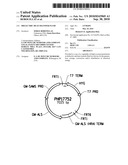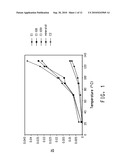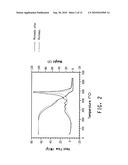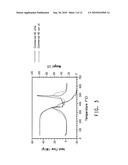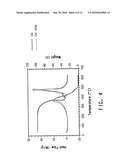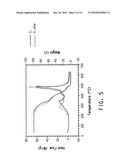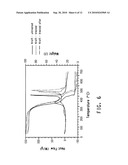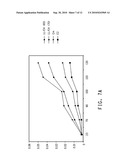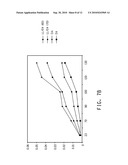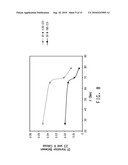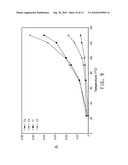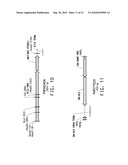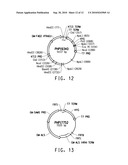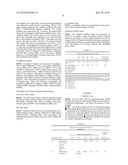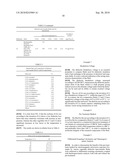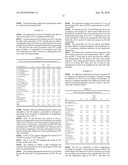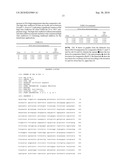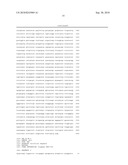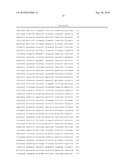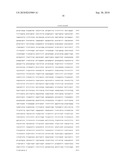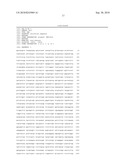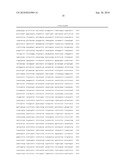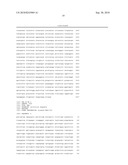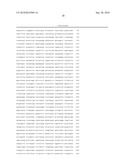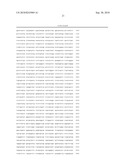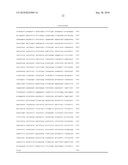Patent application title: DIELECTRIC HEAT-TRANSFER FLUID
Inventors:
Serge Rebouillat (Echenevex, FR)
Serge Rebouillat (Echenevex, FR)
Susan Knowlton (Elkton, MD, US)
Susan Knowlton (Elkton, MD, US)
Assignees:
E. I. DU PONT DE NEMOURS AND COMPANY
IPC8 Class: AH01B320FI
USPC Class:
252579
Class name: Fluent dielectric o-containing carboxylic acid ester
Publication date: 2010-09-30
Patent application number: 20100243969
Claims:
1. A use of a soy oil as a heat-transfer dielectric fluid in a device to
generate, store, convert and/or distribute electrical energy, wherein the
soy oil is one in which at least 70% of the fatty acids are C14 to C22
mono-unsaturated, and less than 16% of the fatty acids are
polyunsaturated.
2. The use according to claim 1, wherein the soy oil has less than 6% of polyunsaturated fatty acids.
3. The use according to claim 1 or 2, wherein the soy oil has at least 80% content of monounsaturated C14 to C22 fatty acids.
4. The use according to any preceding claim, wherein the soy oil has a saturated fatty acid content of less than at or about 12%.
5. The use according to any preceding claim, wherein the soy oil has a saturated fatty acid content of less than at or about 10%.
6. The use according to any preceding claim, wherein the soy oil has less than 4% of polyunsaturated fatty acids.
7. The use according to any preceding claim, wherein the monounsaturated fatty acids are C18 monounsaturated fatty acids.
8. The use according to any preceding claim, wherein the monounsaturated fatty acids are oleic acid.
9. The use according to any one preceding claim, wherein the polyunsaturated fatty acids are C18 fatty acids having two or three double bonds, preferably C18:2 and/or C18:3.
10. The use according to any one preceding claim, wherein the soy oil has the following fatty acid content: at or about 6% C16:0, 3% C18:0, 86% C18:1, 2% C18:2 and 2% C18:3.
11. The use according to any one preceding claim, wherein the soy oil has the following fatty acid content: at or about 6% C16:0, 4% C18:0, 79% C18:1, 4% C18:2, 2% C18:3.
12. The use according to any one preceding claim, wherein the soy oil has the following fatty acid content: at or about 7% C16:0, 4% C18:0, 70% C18:1, 13% C18:2, 3% C18:3.
13. The use according to any one preceding claim, wherein the soy oil has the following fatty acid content: at or about 6% C16:0, 4% C18:0, 74% C18:1, 9% C18:2, 3% C18:3.
14. The use according to any one preceding claim, wherein the soy oil has the following fatty acid content: at or about 6% C16:0, 4% C18:0, 78% C18:1, 4% C18:2, 2% C18:3.
15. The use according to any one preceding claim, wherein the soy oil additionally comprises tocopherol antioxidants, at a concentration of at least 85 mg/100 g of oil.
16. The use according to claim 15, wherein the tocopherol is naturally occurring tocopherols.
17. The use according to any one preceding claim, wherein the soy oil is derived from a seed plant that has been genetically manipulated to increase expression of the gene encoding oleoyl 12-desaturase.
18. The use according to any one preceding claim, wherein the content of C18:2 is less than at or about 5%.
19. A device to generate, store, convert and/or distribute electrical energy, comprising:(a) a conducting material;(b) a dielectric material; and(c) a heat-transfer dielectric fluid, which is a soy oil in which at least 75% of the fatty acids are C14 to C22 mono-unsaturated, and less than 7% of the fatty acids are polyunsaturated.
20. A device according to claim 19, wherein the soy oil is the vegetable oil described in any one of claims 1-18.
21. A device according to claim 19 or 20, wherein the dielectric material is paper or board made of cellulose or aramid, polyimides, polyphenylsulfones, polyamides, polyesters (e.g. PET) and polyethylene and combination therewith in various forms such composites, laminates, morphologically tailored surfaces and/or multidimensional structures and hybrids/mixtures thereof.
22. A method for preconditioning a heat-transfer dielectric fluid which is a vegetable triacylglycerol, comprising the step:(a) exposing said fluid to a constant and uniformly distributed electromagnetic field.
23. The method according to claim 22, wherein the electromagnetic field is in the form of microwaves, which are applied at sufficient power and for sufficient time to heat the vegetable triacylglycerol to at least at or about 100.degree. C., but not higher than at or about 170.degree. C.
24. A dielectric material comprising an organic fibrous structure (e.g. woven or non-woven) impregnated with at least 10% wt of a vegetable triacylglycerol and/or mixtures in which at least 75% of the fatty acids are C14 to C22 mono-unsaturated, and less than 7% of the fatty acids are polyunsaturated.
25. The dielectric material of claim 24, wherein the vegetable triacylglycerol has less than 6% polyunsaturated fatty acids.
26. A blended high oleic oil with an improved Df value at a constant temperature comprising:a) a first oil in the range of 1-100 vol % that is a high oleic soybean oil; andb) a second oil in the range of 1-100 vol %; andc) wherein the blended high oleic oil has an oleic acid content of at least 70%; and wherein the Df value, at a constant temperature, of the blended high oleic oil is improved when compared under the same conditions to an oil not comprising the high oleic soybean oil.
27. The blended high oleic oil of claim 26, having a Df of less than at or about 1.2.times.10.sup.-3 when measured at 23.degree. C.
28. The blended high oleic oil of claim 26, having a Df of less than at or about 5.4.times.10.sup.-3 when measured at 70.degree. C.
29. The blended high oleic oil of claim 26, having a Df of less than at or about 9.1.times.10.sup.-3 when measured at 90.degree. C.
30. The blended high oleic oil of claim 26, having a Df of less than at or about 1.21.times.10.sup.-2 when measured at 100.degree. C.
31. The blended high oleic oil of claim 26, having a Df of less than at or about 1.95.times.10.sup.-2 when measured at 120.degree. C.
32. The blended high oleic oil of claim 26, having a Df of and less than at or about 2.32.times.10.sup.-2 when measured at 130.degree. C.
33. The blended high oleic oil of claim 26, having a Df of less than 2.32.times.10.sup.-2 over a temperature range of at or about 23-130.degree. C.
34. The blended high oleic oil of claim 26, having a Df of less than at or about 2.5.times.10.sup.-4 when measured at 23.degree. C.
35. The blended high oleic oil of claim 26, having a Df of less than at or about 1.5.times.10.sup.-3 when measured at 70.degree. C.
36. The blended high oleic oil of claim 26, having a Df of less than at or about 3.times.10.sup.-3 when measured at 90.degree. C.
37. The blended high oleic oil of claim 26, having a Df of less than at or about 4.times.10.sup.-3 when measured at 100.degree. C.
38. The blended high oleic oil of claim 26, having a Df of less than at or about 7.times.10.sup.-3 when measured at 120.degree. C.
39. The blended high oleic oil of claim 26, having a Df of and less than at or about 1.times.10.sup.-2 when measured at 130.degree. C.
40. The blended high oleic oil of claim 26, having a Df of less than 0.01 over a temperature range of at or about 23-130.degree. C.
41. A blended high oleic oil with an improved Df value at a constant temperature comprising:a) a first oil in the range of 1-100 vol % that is a high oleic soybean oil; andb) a second oil in the range of 1-100 vol % that is a mono-alkyl ester of oleic acid; andc) a third oil in the range of 1-100 vol %; andd) wherein the blended high oleic oil has an oleic acid content of at least 80%; and wherein the Df value, at a constant temperature, of the blended high oleic oil is improved when compared under the same conditions to an oil not comprising the high oleic soybean oil and/or the purified oleic acid and/or any isolated components of the oil that is required to improve the performance of the said high oleic blend.
42. The oil of any one of claims 26-41, wherein the oil comprises at least one antioxidant, selected from the group consisting of: tocopherols, tocotrienols, naturally occurring tocopherols, naturally occurring tocotrienols, Lubrizol 7653, TBHQ, Decanox MPS-90, and/or natural plant extracts.
Description:
FIELD OF THE INVENTION
[0001]The present invention relates to the field of dielectric heat-transfer fluids, in particular dielectric fluid made from vegetable oils for use in, e.g. liquid filled transformers.
BACKGROUND OF THE INVENTION
[0002]Electrical transformers typically have windings of conducting wire which must be separated by a dielectric (i.e. non-conducting) material. Usually the coils and dielectric material are immersed in a fluid dielectric heat transfer medium to insulate the conductor and to dissipate heat generated during operation. The heat-transfer medium must act as a dielectric as well. In a typical arrangement, cellulosic and/or aramid paper or board is used as the dielectric material. The cellulosic/aramid material is wrapped around the conducting wire, and used to separate the windings dielectrically, and may also be used as a structural support for the windings or other elements such as the cores. The fluid heat-transfer medium is typically an oil, which may be, for example mineral oil or a sufficiently robust vegetable oil.
[0003]During use of the transformer, the dielectric material and heat-transfer fluid are subjected to significant electromagnetic fields and significant variations of temperature and power surges and breakdowns. Over time, the relatively extreme conditions can lead to failure of the dielectric material and deterioration of the heat-transfer fluid. Deterioration leads to power loss due to dielectric loss, and may eventually lead to discharges and catastrophic failure of the transformer causing major pollution and/or fires.
[0004]The dielectric and heat-transfer fluid can furthermore be directly and indirectly degraded by oxygen migration and water formation or ingression in the transformer.
[0005]Mineral oil generally shows excellent dielectric and heat-transfer behaviour, however, dielectric heat-transfer fluids are used in enormous quantities, (i.e. several hundreds of thousands of metric tons per year). The public becomes increasingly sensitive to environment and safety concerns around transformer units, and they are therefore subject to more and more stringent regulations. Many heat-transfer fluids currently used (such as mineral oil) pose a serious concern since they are flammable and do not biodegrade within reasonable time frame or simply not at all. Fluids coming from "bio" (i.e. living) sources are increasingly being seen as future fluids for those purposes. For example, U.S. Pat. Nos. 6,905,638 and 7,048,875 disclose transformers using vegetable oils as the heat-transfer fluid. The vegetable oil may contain chemically synthesised anti-oxidants.
[0006]A need remains for improved bio-degradable heat-transfer fluids, which are not limited to food grade oils, showing good performance over time.
SUMMARY OF THE INVENTION
[0007]In a first aspect, the invention provides a use of a soy oil as a heat-transfer dielectric fluid in a device to generate, store, convert and/or distribute electrical energy, wherein the soy oil is one in which at least 70%, preferably at least 75% of the fatty acids are C14 to C22 mono-unsaturated, and less than 16%, preferably less than 7%, more preferably less than 6% of the fatty acids are polyunsaturated.
[0008]In a second aspect, the invention provides a device to generate, store, convert and/or distribute electrical energy and/or optical signals, comprising:
(a) a conducting material;(b) a dielectric material; and(c) a heat-transfer dielectric fluid, which is a soy oil in which at least 70%, preferably at least 75% of the fatty acids are C14 to C22 mono-unsaturated, and less than 16%, preferably less than 7%, more preferably less than 6% of the fatty acids are polyunsaturated.
[0009]In a third aspect, the invention provides a method for preconditioning a heat-transfer dielectric fluid which is a vegetable triacylglycerol, comprising the step:
(a) exposing said fluid to a constant and uniformly distributed electromagnetic field.
[0010]In a fourth aspect, the invention provides a dielectric material comprising an organic fibrous structure (woven or non-woven) impregnated, with at least 1 wt % of a vegetable triacylglycerol, preferably a soy oil, in which at least 70%, preferably at least 75% of the fatty acids are C14 to C22 mono-unsaturated, and less than 16%, preferably less than 7%, more preferably less than 6% of the fatty acids are polyunsaturated.
[0011]In a fifth aspect, the invention provides a use of a vegetable oil as a heat-transfer dielectric fluid in a device to generate, store, convert and/or distribute electrical energy, wherein the vegetable oil is a triacylglycerol having at least one hydroxy fatty acid.
[0012]In a sixth aspect, the invention provides a blended high oleic oil with an improved Df value at a constant temperature comprising:
a) a first oil in the range of 1-100 vol % that is a high oleic soybean oil; andb) a second oil in the range of 1-100 vol %; andc) wherein the blended high oleic oil has an oleic acid content of at least 70%; and wherein the Df value, at a constant temperature, of the blended high oleic oil is improved when compared under the same conditions to an oil not comprising the high oleic soybean oil.
[0013]In a seventh aspect, the invention provides a blended high oleic oil with an improved Df value at a constant temperature comprising:
a) a first oil in the range of 1-100 vol % that is a high oleic soybean oil; andb) a second oil in the range of 1-100 vol % that is a mono-alkyl ester of oleic acid; andc) a third oil in the range of 1-100 vol %; andd) wherein the blended high oleic oil has an oleic acid content of at least 70%; and wherein the Df value, at a constant temperature, of the blended high oleic oil is improved when compared under the same conditions to an oil not comprising the high oleic soybean oil and/or the purified esters of oleic acid.
BRIEF DESCRIPTION OF THE DRAWINGS AND SEQUENCE LISTING
[0014]FIG. 1 shows the dielectric loss factor (Df) vs temperature for comparative fluids C1 (FR3) and C2 (Biotemp) and a fluid for use according to the invention, E1 (one of the oils of the invention, VGO-B1),
wherein the squares .box-solid. and triangles .tangle-solidup. show the loss factor for comparative fluid C1 (FR3) (measured at two different times), the crosses X show the loss factor for comparative fluid C2 (Biotemp), the diamonds .diamond-solid. show the loss factor for a soybean oil for use according to the invention E1 (VGO-B1), and the filled circles show the loss factor for mineral oil, which is included as a reference.
[0015]FIG. 2 shows the thermo-gravimetric pattern and heat flux generated before (dotted lines) and after (solid lines) a pharmaceutical grade of Ricinoleic oil is exposed to the electromagnetic microwave treatment of Example 8.
[0016]FIG. 3 shows the thermo-gravimetric pattern and heat flux generated before (dotted lines) and after (solid lines) a commercial grade of High Oleic Sunflower oil, the comparative fluid C2, is exposed to the electromagnetic microwave treatment of Example 8.
[0017]FIG. 4 shows the thermo-gravimetric pattern and heat flux generated before (solid lines) and after (dotted lines) a commercial grade of normal soybean oil, the comparative fluid C1, was exposed to the electromagnetic microwave treatment of Example 8.
[0018]FIG. 5 shows the thermo-gravimetric pattern and heat flux generated before (solid lines) and after (dotted lines) the fluid for the use of the invention, E1, was exposed to the electromagnetic microwave treatment of Example 8.
[0019]FIG. 6 shows the thermal behaviour of untreated Kraft paper (solid line), Kraft paper imbibed with the fluid for use according to the invention (dotted lines) and Kraft paper imbibed with the fluid for use according to the invention and pre-treated with microwaves according to Example 8 (dash-dot lines).
[0020]FIG. 7A shows the Df value measured vs temperature for soy oils for use according to the invention, E2, such as "HOSO"; designated by squares and high oleic soy oil having 70%, oleic acid and 16% polyunsaturates (designated by triangles), compared to soy oils having 21% oleic acid and 61% polyunsaturates ("Cm"; designated by X's), 65% oleic acid and 20% polyunsaturates (designated by diamonds).
[0021]FIG. 7B shows the DF value measured vs temperature for soy oils for use according to the invention. The crosses designate the results for E4, having 74.36% oleic (74%);
The X's designate the results for the commodity soy oil (Cm) having 21')/0 oleic acid and 61% polyunsaturates.The triangles designate the results for a soy oil blend having 70% oleic and 16% polyunsaturates.The diamonds designate the results for a soy oil blend having 65% oleic and 20% polyunsaturates.
[0022]FIG. 8 shows the variation of Df vs oleic acid content for blended soy oils at two different temperatures (upper line: 130° C.; lower line: 90° C.).
[0023]FIG. 9 shows the dielectric loss factor (Df) vs temperature for comparative fluids C1 (FR3) and C2 (Biotemp) and two oils for use according to the invention, E2 (E1, VGO-B1) and E4 (E1, VGO-B2).
wherein the squares show the loss factor for comparative fluid C1, the open triangles .tangle-solidup. show the loss factor for comparative fluid C2, the diamonds .diamond-solid. show the loss factor for a soybean oils for use according to the invention E2 and E4.
[0024]FIG. 10 depicts fragment PHP19340A.
[0025]FIG. 11 depicts fragment PHP17752A.
[0026]FIG. 12 depicts plasmid PHP19340.
[0027]FIG. 13 depicts plasmid PHP17752.
[0028]SEQ ID NO: 1 sets forth the nucleotide sequence of plasmid PHP19340A.
[0029]SEQ ID NO: 2 sets forth the nucleotide sequence of plasmid PHP17752A.
[0030]SEQ ID NO: 3 sets forth the nucleotide sequence of plasmid PHP19340.
[0031]SEQ ID NO: 4 sets forth the nucleotide sequence of plasmid PHP17752.
DETAILED DESCRIPTION OF PREFERRED EMBODIMENTS
[0032]The expressions dielectric loss factor, dielectric loss value, Df value, Df, or dielectric dissipation loss are used interchangeably herein. Df and Tan delta are frequently quoted in the literature as being equivalent.
[0033]The expression "E1" is directed to all the high oleic soy oils of the invention and includes the range of the fatty acid compositions shown in Table 1 and includes without limitation the following oils: VGO-B1, VGO-B2, HOSO, the 70% oleic soybean oil shown in Table 6, E2, and E4.
Methods
[0034]Fatty acid contents of oils may be determined using gas chromatography with flame ionization detection, or reverse-phase liquid chromatography with fluorescence detection. Percentages quoted relate to relative percent expressed as %, i.e. the area under the peak of one specific fatty acid divided by the sum of the peak areas of all fatty acid in a particular sample, unless stated otherwise.
[0035]Tocopherol content of oils is determined using an HPLC method.
[0036]The inventors found that a soy oil having a relatively high (i.e. at least 70%, preferably at least 75% of the fatty acids) content of monounsaturated C14 to C22 fatty acids, and less than 16%, preferably less than 7%, more preferably less than 6% of polyunsaturated fatty acids, gives particularly good performance as a heat-transfer dielectric fluid.
[0037]More preferably, the soy oil for use according to the invention has at least 80% content of monounsaturated C14 to C22 fatty acids, particularly preferably at least 82%, preferably at least 84% content of monounsaturated C14 to C22 fatty acids, or at or about 85% content of monounsaturated C14 to C22 fatty acids.
[0038]More preferably, the soy oil for use according to the invention has less than 4% of polyunsaturated fatty acids.
[0039]In a preferred embodiment, the soy oil for use according to the invention has at least 80% content of monounsaturated C14 to C22 fatty acids, and less than 4% of polyunsaturated fatty acids.
[0040]More preferably, the monounsaturated fatty acids are C18 monounsaturated fatty acids. Most preferably, they are oleic acid.
[0041]More preferably, the polyunsaturated fatty acids are C18 fatty acids having two or three double bonds, for example C18:2 and/or C18:3.
[0042]Preferably C18:2 is less than or equal to 5%.
[0043]More preferably, the soy oil has a C18:1 content of greater than about 75% of the fatty acid moieties, and a combined C18:2 and C18:3 content of less than 7%, more preferably less than 6% of the fatty acid.
[0044]In a preferred embodiment, the soy oil has a saturated fatty acid content of less than at or about 12%, more preferably less than at or about 10%. Higher saturated fatty acid content leads to an undesirable higher pour point, and diminished dynamic heat transfer ability.
[0045]In a particularly preferred embodiment, the soy oil has the following fatty acid content: at or about 6% C16:0, 3% C18:0, 86% C18:1, 2% C18:2 and 0-2% C18:3.
[0046]In another particularly preferred embodiment, the soy oil has the following fatty acid content: at or about 6% C16:0, 4% C18:0, 79% C18:1, 4% C18:2, 2% C18:3.
[0047]In another preferred embodiment, the soy oil has the following fatty acid content: at or about (see table below):
TABLE-US-00001 Fatty acid % C14:0 (myristic) 0.04 C15:0 (pentadecanoic) 0.03 C16:0 (palmitic) 6.15 C16:1 n-7 (palmitoleic) 0.10 C17:0 (margaric) 0.81 C18:0 (stearic) 3.85 C18:1 n-9 (oleic) 77.74 C18:1 (octadecenoic) 1.30 C18:2 n-6 (linoleic) 4.20 C18:3 n-3 (alpha-linoleic) 2.19 C20:0 (arachidic) 0.39 C20:1 n-9 (eicosenoic) 0.38 C20:1 n-9 (eicosadienoic) 0.40 Total polyunsaturates 6.79 C22:0 (behenic) 0.01 C24:0 (lignoceric) 0.16 Others 0.90
[0048]The soy oil preferably has a water content of less than at or about 300 ppm.
[0049]In a preferred embodiment, the soy oil additionally comprises tocopherol antioxidants. Preferably the tocopherols are present at a concentration of at least 85 mg/100 g of oil, more preferably at least 100 mg/100 g of oil, as measured by a known HPLC method. The tocopherol may be selected from naturally occurring tocopherols, in particular alpha-, beta- and gamma- and delta-tocopherols, and mixtures of these.
[0050]In a particularly preferred embodiment, the soy oil has a tocopherol content as measured by a known HPLC method of at or about 160 mg/100 g oil, and has the following fatty acid content: at or about 6% C16:0, 3% C18:0, 86% C18:1, 2% C18:2 and 2% C18:3.
[0051]In another particularly preferred embodiment, the soy oil has a tocopherol content as measured by a known HPLC method of at or about 160 mg/100 g oil, and has the following fatty acid content: at or about 6% C16:0, 4% C18:0, 79% C18:1, 4% C18:2, 2% C18:3.
[0052]The tocopherol is preferably tocopherol which is present in the soy oil or in any other vegetable oil as derived from the plant source or in natural plant extracts, NPE (i.e. as opposed to synthesized tocopherol that is added).
[0053]The soy oil may additionally comprise additives known in the art, which comprise generally less than 5 wt % of the dielectric heat-transfer fluid, for example: bactericides, metal chelators, corrosion inhibitors, antioxidants, heat-stabiliser, viscosity adjusters, pour point depressants, including natural plant extract promoting those functionalities etc.
[0054]The soy oil for use according to the invention can be blended with other fluids used for dielectric heat-transfer fluids, such as other vegetable oils, mineral oil, etc.
[0055]In a particularly preferred embodiment, the oil is derived from soybeans prepared by recombinant manipulation to give increased expression of the activity of the gene encoding oleoyl 12-desaturase.
[0056]An exemplary description of a suitable genetic manipulation in soybeans is described in U.S. Pat. No. 5,981,781 (E.I. du Pont de Nemours and Company), and is detailed below:
[0057]In soy (Glycine max) there are two genes encoding oleoyl 12-desaturase activity, one of which (GmFad 2-1) is expressed only in the developing seed (Heppard et al. (1996) Plant Physiol. 110:311-319). The expression of this gene increases during the period of oil deposition, starting around 19 days after flowering, and its gene product is responsible for the synthesis of the polyunsaturated fatty acids found in soybean oil. GmFad 2-1 is described in detail by Okuley, J. et al. (1994) Plant Cell 6:147-158 and in WO94/11516. It is available from the ATCC in the form of plasmid pSF2-169K (ATCC accession number 69092). The other gene (GmFad 2-2) is expressed in the seed, leaf, root and stem of the soy plant at a constant level and is the "housekeeping" 12-desaturase gene. The Fad 2-2 gene product is responsible for the synthesis of polyunsaturated fatty acids for cell membranes.
[0058]GmFad 2-1 was placed under the control of a strong, seed-specific promoter derived from the α'-subunit of the soybean (Glycine max) beta-conglycinin gene. This promoter allows high level, seed specific expression of the trait gene. It spans the 606 by upstream of the start codon of the α' subunit of the Glycine max β-conglycinin storage protein. The β-conglycinin promoter sequence represents an allele of the published β-conglycinin gene (Doyle et al., (1986) J. Biol. Chem. 261:9228-9238) having differences at 27 nucleotide positions. It has been shown to maintain seed specific expression patterns in transgenic plants (Barker et al., (1988) Proc. Natl. Acad. Sci. 85:458-462 and Beachy et al., (1985) EMBO J. 4:3047-3053). The reading frame was terminated with a 3' fragment from the phaseolin gene of green bean (Phaseolus vulgaris). This is a 1174 by stretch of sequences 3' of the Phaseolus vulgaris phaseolin gene stop codon (originated from clone described in Doyle et al., 1986).
[0059]The GmFad 2-1 open reading frame (ORF) was in a sense orientation with respect to the promoter so as to produce a gene silencing of the sense GmFad 2-1 cDNA and the endogenous GmFad 2-1 gene. This phenomenon, known as "sense suppression" is an effective method for deliberately turning off genes in plants and is described in U.S. Pat. No. 5,034,323.
[0060]For maintenance and replication of the plasmid in E. coli the GmFad 2-1 transcriptional unit described above was cloned into plasmid pGEM-9z (-) (Promega Biotech, Madison Wis., USA).
[0061]For identification of transformed soybean plants the β-glucuronidase gene (GUS) from E. coli was used. The cassette used consisted of the three modules; the Cauliflower Mosaic Virus 35S promoter, the β-glucuronidase gene (GUS) from E. coli and a 0.77 kb DNA fragment containing the gene terminator from the nopaline synthase (NOS) gene of the Ti-plasmid of Agrobacterium tumefaciens. The 35S promoter is a 1.4 kb promoter region from CaMV for constitutive gene expression in most plant tissues (Odell et al. (1985) Nature 303:810-812), the GUS gene a 1.85 kb fragment encoding the enzyme β-glucuronidase (Jefferson et al. (1986) PNAS USA 83:8447-8451) and the NOS terminator a portion of the 3' end of the nopaline synthase coding region (Fraley et al., (1983) PNAS US 80:48034807). The GUS cassette was cloned into the GmFad 2-1/pGEM-9z (-) construct and was designated pBS43.
[0062]Plasmid pBS43 was transformed into meristems of the elite soybean line A2396, by the method of particle bombardment (Christou et al., (1990) Trends Biotechnol. 8:145-151). Fertile plants were regenerated using methods well known in the art.
[0063]From the initial population of transformed plants, a plant was selected which was expressing GUS activity and which was also positive for the GmFad 2-1 gene (Event 260-05) when evaluated by PCR. Small chips were taken from a number of R1 seeds of plant 260-05 and screened for fatty acid composition. The chipped seed was then planted and germinated. Genomic DNA was extracted from the leaves of the resulting plants and cut with the restriction enzyme Bam HI. The blots were probed with a phaseolin probe.
[0064]From the DNA hybridization pattern it was clear that in the original transformation event the GmFad 2-1 construct had become integrated at two different loci in the soybean genome. At one locus (Locus A) the GmFad 2-1 construct was causing a silencing of the endogenous GmFad 2-1 gene, resulting in a relative oleic acid content of about 85% (compared with about 20% in elite soybean varieties). At locus A there were two copies of pBS43. On the DNA hybridization blot this was seen as two cosegregating bands. At the other integration locus (Locus B) the GmFad 2-1 was over-expressing.
[0065]Fourth generation segregant lines (R4 plants), generated from the original transformant, were allowed to grow to maturity. R4 seeds, which contained only the silencing Locus A (e.g., G94-1) did not contain any detectable GmFad 2-1 mRNA (when measured by Northern blotting) in samples recovered 20 days after flowering. GmFad 2-2 mRNA, although reduced somewhat compared with controls, was not suppressed. Thus the GmFad 2-1 sense construct had the desired effect of preventing the expression of the GmFad 2-1 gene and thus increasing the oleic acid content of the seed. All plants homozygous for the GmFad 2-1 silencing locus had an identical Southern blot profile over a number of generations. This indicates that the insert was stable and at the same position in the genome over at least four generations.
[0066]The soy oil is extracted from the plant source using known methods of extraction. Preferred methods of extractions are those that avoid steps that result in destruction of the natural tocopherol content. For example, it is preferred to avoid heating the oil to above 200° C. for prolonged periods, for example during deodorization steps which can be reduced or eliminated. In some instances it might be preferred to avoid hydrogenation.
[0067]It is also preferred to take fractions of the oil, which are "first" extracted meaning prior to a more exhaustive extraction of the oil out of the seed. Physical extraction is preferred over solvent extraction or any combined extraction process, which privileges the physical extraction step.
[0068]Methods for the extraction and processing of soybean seeds to produce soybean oil and meal are well known throughout the soybean processing industry. In general, soybean oil is produced using a series of steps which accomplish the extraction and purification of an edible oil product from the oil bearing seed. The oils of the invention are not limited to food-grade oils. Soybean oils and soybean by-products are produced using the generalized steps shown in the diagram below.
##STR00001##
[0069]Soybean seeds are cleaned, tempered, dehulled, and flaked which increases the efficiency of oil extraction. Oil extraction is usually accomplished by solvent (hexane) extraction but can also be achieved by a combination of physical pressure and/or solvent extraction. The resulting oil is called crude oil. The crude oil may be degummed by hydrating phospholipids and other polar and neutral lipid complexes which facilitate their separation from the nonhydrating, triglyceride fraction (soybean oil). The resulting lecithin gums may be further processed to make commercially important lecithin products used in a variety of food and industrial products as emulsification and release (antisticking) agents. Degummed oil may be further refined for the removal of impurities; primarily free fatty acids, pigments, and residual gums. Refining is accomplished by the addition of caustic which reacts with free fatty acid to form soap and hydrates phosphatides and proteins in the crude oil. Water is used to wash out traces of soap formed during refining. The soapstock by-product may be used directly in animal feeds or acidulated to recover the free fatty acids. Color is removed through adsorption with a bleaching earth, powdered activated carbon and/or synthetic neutral resin. Which removes most of the chlorophyll and carotenoid compounds. Deodorization which is principally steam distillation under vacuum, is the last step and is designed to remove compounds which impart odor or flavor to the oil. A more detailed reference to soybean seed processing, soybean oil production and by-product utilization can be found in Erickson, 1995, Practical Handbook of Soybean Processing and Utilization, The American Oil Chemists' Society and United Soybean Board.
[0070]A second aspect of the invention provides a device to generate, store, convert and/or distribute electrical energy with or without optical signals therewith, comprising:
(a) a conducting material;(b) a dielectric material; and(c) a heat-transfer dielectric fluid, which is a soy oil in which at least 70%, preferably at least 75% of the fatty acids are C14 to C22 mono-unsaturated, and less than 16%, preferably less than 7%, more preferably less than 6% of the fatty acids are polyunsaturated.
[0071]The heat-transfer dielectric fluid used in the device of the invention may be any of the preferred oils for use in the invention described herein and any mixtures thereof.
[0072]In a preferred embodiment, the device is a transformer. Typically, the transformer will have conducting material in the form of coils or windings of conducting wire and connections (e.g. copper, aluminium, iron, steel, silver, etc.). The conducting material is wound around and covered in the dielectric material, which is typically chosen from woven or non-woven fibrous material, films and laminates, such as paper, board and/or multidimensional structures. The paper or board may be cellulosic or it may be, for example, composed of aramid fibres, preferably m-aramid fibres, polyimides, polyphenylsulfones, polyamides, polyesters (e.g. PET) and polyethylene, and combination therewith in various forms composites, laminates and tailored morphologically tailored surfaces and/or multidimensional structures and hybrids/mixtures thereof. The conducting material and the dielectric material are placed in a receptacle and the dielectric heat-transfer fluid is added to submerse or partially submerse the components. Alternatively, the dielectric material (e.g. paper or board) is impregnated with the dielectric heat-transfer fluid by absorption ("imbibing") at various stages of its processing.
[0073]In another preferred embodiment, the dielectric heat-transfer fluid may be used for example in a generator, a capacitor, an inverter or electric motor, a switch and cables.
[0074]A third aspect of the invention is a method for preconditioning a heat-transfer dielectric fluid which is a vegetable triacylglycerol, comprising the step:
(a) exposing said fluid to a constant and uniformly distributed electromagnetic field. The electromagnetic field may be applied continuously or in series of constant and/or variable pulse and relaxation sequences; repeating the exposure as often as needed.
[0075]The beneficial effect of the pre-treatment extends to all triacylglycerol dielectric heat-transfer fluids and mixtures thereof, and is not limited to the fluid used in the use according to the invention.
[0076]In a preferred embodiment, the electromagnetic field is applied in the form of microwaves.
[0077]Preferably the electromagnetic field is applied at sufficient power and for a sufficient period of time to treat the vegetable triacylglycerol to at least at or about 100° C., preferably at least at or about 120° C., but not higher than at or about 170° C., more preferably not higher than at or about 160° C. It is particularly preferred to heat the vegetable triacylglycerol to at or about 140° C.
[0078]After exposing the fluid to the electromagnetic filed, it is allowed to cool.
[0079]In one embodiment, the vegetable triacylglycerol is exposed to the electromagnetic field as a neat fluid (i.e. in a suitable receptacle), and then used as desired. In another embodiment, the vegetable triacylglycerol is first applied to an absorbent dielectric material, such as paper (e.g. cellulosic or aramid), and then the imbibed paper is subjected to the electromagnetic field including in-line processing treatment. Such in-line or off-line processing treatments will be preferably performed in a way that maximize the exposure of the oil to the electromagnetic field such as reducing gradients, mainly temperature and/or electromagnetic radiation flux, within the bulk of the material treated. Falling film transfer equipment and/or droplet chambers are suitable.
[0080]A fourth aspect of the invention is a dielectric material comprising an organic fibrous structure (e.g. woven tissues or textiles or non-woven) impregnated with at least 1 wt % of a vegetable triacylglycerol, preferably a soy oil, in which at least 70%, preferably at least 75% of the fatty acids are C14 to C22 mono-unsaturated, and less than 16%, preferably less than 7%, more preferably less than 6% of the fatty acids are polyunsaturated.
[0081]The vegetable triacylglycerol used for impregnation may be any of the fluids for use according to the invention described herein.
[0082]In a preferred embodiment, the organic fibrous structure is a non-woven made of cellulosic or aramid fibres, polyimides, polyphenylsulfones, polyamides, polyesters (e.g. PET) and polyethylene and combination therewith in various forms composites, laminates and tailored morphologically tailored surfaces and/or multidimensional structures and hybrids/mixtures thereof.
[0083]The vegetable triacylglycerol is preferably present at about 1 wt %-10 wt %, more preferably 10 wt % to about 50 wt %, even more preferably at or about 20 wt % to 40 wt %.
[0084]In a fifth aspect, the invention provides a use of a vegetable oil as a heat-transfer dielectric fluid in a device to generate, store, convert and/or distribute electrical energy, wherein the vegetable oil is a triacylglycerol having at least one hydroxy fatty acid. Preferably the hydroxyl fatty acid is cis-12-hydroxyoctadec-9-enoic acid, preferably having the D configuration at the chiral carbon. In a particularly preferred embodiment all of the fatty acids in the triacylglycerol are D-cis-12-hydroxyoctadec-9-enoic acid (Castor oil or ricinoleic acid) and this triacylglycerol is mixed in varying proportions with a triacylglycerol in which at least 70%, preferably at least 75% of the fatty acids are C14 to C22 mono-unsaturated, and less than 16%, preferably less than 7%, more preferably less than 6% of the fatty acids are polyunsaturated. Preferably, in a blend, the castor oil represents from 5 to 15% of the triacylglycerol.
[0085]The term "high oleic soybean" refers to soybean seeds that have an oleic acid content of at least 60%, 61%, 62%, 63%, 64%, 65%, 66%, 67%, 68%, 69%, 70%, 71%, 72%, 73%, 74%, 75%, 76%, 77%, 78%, 79%, 80%, 81%, 82%, 83%, 84%, 85%, 86%, 87%, 88%, 89%, 90%, 91%, 92%, 93%, 94%, and 95%. Preferred high oleic soybean oil starting materials are disclosed in World Patent Publication WO94/11516, the disclosure of which is hereby incorporated by reference.
[0086]The term "high oleic oil" refers to an oil having an oleic acid content of at least 70%, 71%, 72%, 73%, 74%, 75%, 76%, 77%, 78%, 79%, 80%, 81%, 82%, 83%, 84%, 85%, 86%, 87%, 88%, 89%, 90%, 91%, 92%, 93%, 94%, and 95%.
[0087]Useful examples of contents of polyunsaturated of the oil for the use of the present invention are less than 16%, 15%, 14%, 13%, 12%, 11%, 10%, 9%, 8%, 7%, 6%, 5%, 4%, 3%, 2%, 1%.
[0088]In a sixth aspect, the invention provides a blended high oleic oil with an improved Df value at a constant temperature comprising:
a) a first oil in the range of 1-100 vol % that is a high oleic soybean oil; andb) a second oil in the range of 1-100 vol %; andc) wherein the blended high oleic oil has an oleic acid content of at least 70%; and wherein the Df value, at a constant temperature, of the blended high oleic oil is improved when compared under the same conditions to an oil not comprising the high oleic soybean oil.
[0089]Useful examples of percent volume for the oils a) and b) of the blended oil of the invention are 1%, 2%, 3%, 4%, 5%, 6%, 7%, 8%, 9%, 10%, 11%, 12%, 13%, 14%, 15%, 16%, 17%, 18%, 19%, 20%, 21%, 22%, 23%, 24%, 25%, 26%, 27, 28%, 29%, 30%, 31%, 32%, 33%, 34%, 35%, 36%, 37%, 38%, 39%, 40%, 41%, 42%, 43%, 44%, 45%, 46%, 47%, 48%, 49%, 50%, 51%, 52%, 53%, 54%, 55%, 56%, 57%, 58%, 59%, 60%, 61%, 62%, 63%, 64%, 65%, 66%, 67%, 68%, 69%, 70%, 71%, 72%, 73%, 74%, 75%, 76%, 77%, 78%, 79%, 80%, 81%, 82%, 83%, 84%, 85%, 86%, 87%, 88%, 89%, 90%, 91%, 92%, 93%, 94%, 95%, 96%, 97%, 98%, 99%, and 100%. The amount of oil which can be used will depend upon the desired properties sought to be achieved in the resulting final blended oil product.
[0090]In a seventh aspect, the invention provides a blended high oleic oil with an improved Df value at a constant temperature comprising:
a) a first oil in the range of 1-100 vol % that is a high oleic soybean oil; andb) a second oil in the range of 1-100 vol % that is a mono-alkyl ester of oleic acid; andc) a third oil in the range of 1-100 vol %; andd) wherein the blended high oleic oil has an oleic acid content of at least 70%; and wherein the Df value, at a constant temperature, of the blended high oleic oil is improved when compared under the same conditions to an oil not comprising the high oleic soybean oil and/or the purified esters of oleic acid.
[0091]Useful examples of percent volume for the oils a), b) and c) of the blended oil of the invention are 1%, 2%, 3%, 4%, 5%, 6%, 7%, 8%, 9%, 10%, 11%, 12%, 13%, 14%, 15%, 16%, 17%, 18%, 19%, 20%, 21%, 22%, 23%, 24%, 25%, 26%, 27, 28%, 29%, 30%, 31%, 32%, 33%, 34%, 35%, 36%, 37%, 38%, 39%, 40%, 41%, 42%, 43%, 44%, 45%, 46%, 47%, 48%, 49%, 50%, 51%, 52%, 53%, 54%, 55%, 56%, 57%, 58%, 59%, 60%, 61%, 62%, 63%, 64%, 65%, 66%, 67%, 68%, 69%, 70%, 71%, 72%, 73%, 74%, 75%, 76%, 77%, 78%, 79%, 80%, 81%, 82%, 83%, 84%, 85%, 86%, 87%, 88%, 89%, 90%, 91%, 92%, 93%, 94%, 95%, 96%, 97%, 98%, 99%, and 100%. The amount of oil which can be used will depend upon the desired properties sought to be achieved in the resulting final blended oil product.
[0092]The oil b) that is a mono-alkyl ester of oleic acid can be any C1-C12alkyl ester of oleic acid. Particularly preferred are C1-C8alkyl esters, more preferably C1-C6alkyl esters, such as methyl, ethyl, propyl, butyl, pentyl and hexyl esters, both straight and branched.
[0093]The oil described herein was tested for its suitability as a heat-transfer dielectric fluid by measuring the dielectric dissipation loss, Df. Df is an important parameter to compare fluids used for dielectric insulation and/or heat transfer in the presence of electrical and/or magnetic fields.
[0094]The dielectric dissipation loss, Df, in part, represents the tendency of the fluid in an alternating electromagnetic field to depart from the ideal of a pure dielectric medium in which no energy dissipation losses would occur. The dielectric loss typically increases with the presence of impurities in the fluid, especially charged impurities, with increase in water content, with free acids and with molecular breakdown of the fluid into smaller species. Furthermore, the stability of the dielectric loss versus temperature within a representative temperature range is an insurance of a durable fluid composition exhibiting good performance over prolonged period of time (i.e. good aging behaviour).
[0095]The measurement of Df is made using ASTM D924, and is based on the superheterodyne principle.
[0096]In one aspect the soy oil or blended oil for use according to the invention preferably shows a Df of less than at or about 1.2×10-3 when measured at 23° C., preferably less than at or about 5.4×10-3 when measured at 70° C., preferably less than 9.1×10-3 when measured at 90° C., preferably less than at or about 1.21×10-2 when measured at 100° C., preferably less than at or about 1.95×10-2 when measured at 120° C., preferably less than at or about 2.32×10-2 when measured at 130° C., and preferably, it shows a Df of less than at or about 2.32×10-2 over a temperature range of at or about 23-130° C.
[0097]In another aspect the soy oil or blended oil for use according to the invention preferably shows a Df of less than at or about 2.5×10-4 when measured at 23° C., preferably less than at or about 2.5×10-3, more preferably less than at or about 1.5×10-3 when measured at 70° C., preferably less than at or about 5×10-3, more preferably less than at or about 3×10-3 when measured at 90° C., preferably less than at or about 7×10-3, more preferably less than at or about 4×10-3 when measured at 100° C., preferably less than at or about 2×10-2, more preferably less than at or about 7×10-3 when measured at 120° C., and preferably less than at or about 2×10-2, more preferably less than at or about 1×10-2 when measured at 130° C. Preferably, it shows a Df of less than at or about 2×10-2, more preferably less than at or about 1×10-2 over a temperature range of at or about 23-130° C.
[0098]In one aspect for the use according to the invention, a blended oil may be used. Such blends are made by blending a high oleic soy oil having an oleic acid content of at least 70%, preferably at least 75% with another oil, preferably a vegetable oil. The quantity of high oleic soy oil to be added to another oil may be determined by titration: the high oleic soy oil may be added until the blended oil has a Df of less than at or about 1.2×10-3 when measured at 23° C., preferably less than at or about 5.4×10-3 when measured at 70° C., preferably less than 9.1×10-3 when measured at 90° C., preferably less than at or about 1.21×10-2 when measured at 100° C., preferably less than at or about 1.95×10-2 when measured at 120° C., preferably less than at or about 2.32×10-2 when measured at 130° C., and preferably, it shows a Df of less than at or about 2.32×10-2 over a temperature range of at or about 23-130° C.
[0099]The high oleic soy oil that is used for blending preferably has a polyunsaturated content of less than at or about 16%, more preferably less than at or about 7%.
[0100]In another aspect for the use according to the invention, a blended oil may be used. Such blends are made by blending a high oleic soy oil having an oleic acid content of at least 70%, preferably at least 75% with another oil, preferably a vegetable oil. The quantity of high oleic soy oil to be added to another oil may be determined by titration: the high oleic soy oil may be added until the blended oil has a Df of less than at or about 2.5×10-4 when measured at 23° C., preferably less than at or about 2.5×10-3, more preferably less than at or about 1.5×10-3 when measured at 70° C., preferably less than at or about 5×10-3, more preferably less than at or about 3×10-3 when measured at 90° C., preferably less than at or about 7×10-3, more preferably less than at or about 4×10-3 when measured at 100° C., preferably less than at or about 2×10-2, more preferably less than at or about 7×10-3 when measured at 120° C., and preferably less than at or about 2×10-2, more preferably less than at or about 1×10-2 when measured at 130° C. Preferably, the blended oil shows a Df of less than at or about 0.02, more preferably less than at or about 1×10-2 over a temperature range of at or about 23-130° C. The high oleic soy oil that is used for blending preferably has a polyunsaturated content of less than at or about 16%, more preferably less than at or about 7%.
[0101]A dynamic (natural or forced) heat transfer takes place in most electrical equipment cooled and electrically insulated with oils. The heating of a liquid filled transformer must be controlled, in large proportion by the coolant and dielectric fluid, taking into account fairly large temperature variations, between the internal hotspots and the external temperature extremes, in winter and in summer. Under good controlled conditions the transformer can be in operation for more than 30 years; but can also be quickly damaged with relatively small deviations, sometime less than 10° C., from the ideal operating temperature defined for each category of transformers and the energy transformation load for which they have been designed.
[0102]At least four important properties of the oil vary with temperature, each of them at various degrees leading to reversible or irreversible property changes in the dielectric heat-transfer fluid (oil). These properties are the density, the thermal conductivity, the dynamic viscosity (all three of which decrease with increasing temperature) and the specific heat (which increases with increasing temperature).
[0103]For an oil temperature variation from 25° C. to 85° C., it is preferred that the density change be less than at or about 5%, the conductivity change be less than at or about 3%, the heat capacity change be less than at or about 10%. The viscosity change is by far the most substantial, since it can reach 50% for the same range of temperature.
[0104]Therefore the viscosity, which contributes to the fluid mechanics via the Re number (Reynold Re=(velocity.diameter.density)/viscosity), directly impacts the fluid's heat-transfer capability, yielding a poorer heat transfer when the viscosity increases and a better one if the viscosity decreases.
EXAMPLES
Example 1
Transformation of Soybean (Glycine max)
Embryo Cultures and Regeneration of Soybean Plants.
[0105]Soybean embryogenic suspension cultures are transformed by the method of particle gun bombardment using procedures known in the art (Klein et al. (1987) Nature (London) 327:70 73; U.S. Pat. No. 4,945,050; Hazel et al. (1998) Plant Cell. Rep. 17:765 772; Samoylov et al. (1998) In Vitro Cell Dev. Biol. Plant 34:8 13). In particle gun bombardment procedures it is possible to use purified 1) entire plasmid DNA or, 2) DNA fragments containing only the recombinant DNA expression cassette(s) of interest.
[0106]Stock tissue for transformation experiments are obtained by initiation from soybean immature seeds. Secondary embryos are excised from explants after 6 to 8 weeks on culture initiation medium. The initiation medium is an agar solidified modified MS (Murashige and Skoog (1962) Physiol. Plant. 15:473 497) medium supplemented with vitamins, 2, 4-D and glucose. Secondary embryos are placed in flasks in liquid culture maintenance medium and maintained for 7-9 days on a gyratory shaker at 26+/-2° C. under ˜80 μEm-2s-1 light intensity. The culture maintenance medium is a modified MS medium supplemented with vitamins, 2, 4-D, sucrose and asparagine. Prior to bombardment, clumps of tissue are removed from the flasks and moved to an empty 60×15 mm petri dish for bombardment. Tissue is dried by blotting on Whatman #2 filter paper. Approximately 100-200 mg of tissue corresponding to 10-20 clumps (1-5 mm in size each) are used per plate of bombarded tissue.
[0107]After bombardment, tissue from each bombarded plate is divided and placed into two flasks of liquid culture maintenance medium per plate of bombarded tissue. Seven days post bombardment, the liquid medium in each flask is replaced with fresh culture maintenance medium supplemented with 100 ng/ml selective agent (selection medium). For selection of transformed soybean cells the selective agent used can be a sulfonylurea (SU) compound with the chemical name, 2 chloro N ((4 methoxy 6 methyl 1,3,5 triazine 2 yl)aminocarbonyl)benzenesulfonamide (common names: DPX-W4189 and chlorsulfuron). Chlorsulfuron is the active ingredient in the DuPont sulfonylurea herbicide, GLEAN®. The selection medium containing SU is replaced every week for 6-8 weeks. After the 6-8 week selection period, islands of green, transformed tissue are observed growing from untransformed, necrotic embryogenic clusters. These putative transgenic events are isolated and kept in media with SU at 100 ng/ml for another 2-6 weeks with media changes every 1-2 weeks to generate new, clonally propagated, transformed embryogenic suspension cultures. Embryos spend a total of around 8-12 weeks in contact with SU. Suspension cultures are subcultured and maintained as clusters of immature embryos and also regenerated into whole plants by maturation and germination of individual somatic embryos.
Example 2
Genetic Material Used to Produce the High Oleic Trait
[0108]A Soybean (Glycine max) event was produced by particle co-bombardment as described in Example 1 with fragments PHP19340A (FIG. 10; SEQ ID NO: 1) and PHP17752A (FIG. 11; SEQ ID NO: 2). These fragments were obtained by Asc I digestion from a source plasmid. Fragment PHP19340A was obtained from plasmid PHP19340 (FIG. 12; SEQ ID NO: 3) and fragment PHP17752A was obtained from plasmid PHP17752 (FIG. 13; SEQ ID NO: 4). The PHP19340A fragment contains a cassette with a 597 by fragment of the soybean microsomal omega-6 desaturase gene 1 (gm-fad2-1) (Heppard et al., 1996, Plant Physiol. 110: 311-319).
[0109]The presence of the gm-fad2-1 fragment in the expression cassette acts to suppress expression of the endogenous omega-6 desaturases, resulting in an increased level of oleic acid and decreased levels of palmitic, linoleic, and linolenic acid levels. Upstream of the gm-fad2-1 fragment is the promoter region from the Kunitz trypsin inhibitor gene 3 (KTi3) (Jofuku and Goldberg, 1989, Plant Cell 1: 1079-1093; Jofuku et al., 1989, Plant Cell 1: 427-435) regulating expression of the transcript. The KTi3 promoter is highly active in soy embryos and 1000-fold less active in leaf tissue (Jofuku and Goldberg, 1989, Plant Cell 1: 1079-1093). The 3' untranslated region of the KTi3 gene (KTi3 terminator) (Jofuku and Goldberg, 1989, Plant Cell 1: 1079-1093) terminates expression from this cassette.
[0110]The PHP17752A fragment contains a cassette with a modified version of the soybean acetolactate synthase gene (gm-hra) encoding the GM-HRA protein with two amino acid residues modified from the endogenous enzyme and five additional amino acids at the N-terminal region of the protein derived from the translation of the soybean acetolactate synthase gene 5' untranslated region (Falco and Li, 2003, US Patent Application: 2003/0226166). The gm-hra gene encodes a form of acetolactate synthase, which is tolerant to the sulfonylurea class of herbicides. The GM-HRA protein is comprised of 656 amino acids and has a molecular weight of approximately 71 kDa.
[0111]The expression of the gm-hra gene is controlled by the 5' promoter region of the S-adenosyl-L-methionine synthetase (SAMS) gene from soybean (Falco and Li, 2003, US Patent Application: 2003/0226166). This 5' region consists of a constitutive promoter and an intron that interrupts the SAMS 5' untranslated region (Falco and Li, 2003). The terminator for the gm-hra gene is the endogenous soybean acetolactate synthase terminator (als terminator) (Falco and Li, 2003, US Patent Application: 2003/0226166).
Example 3
Transformation and Selection for the Soybean High Oleic Event
[0112]For transformation of soybean tissue, a linear portion of DNA, containing the gm-fad2-1 gene sequence and the regulatory components necessary for expression, was excised from the plasmid PHP19340 through the use of the restriction enzyme Asc I and purified using agarose gel electrophoresis. A linear portion of DNA, containing the gm-hra gene sequences and the regulatory components necessary for expression, was excised from the plasmid PHP17752 through the use of the restriction enzyme Asc I and purified using agarose gel electrophoresis. The linear portion of DNA containing the gm-fad2-1 gene is designated insert PHP19340A and is 2924 by in size. The linear portion of DNA containing the gm-hra gene is designated insert PHP17752A and is 4511 by in size. The only DNA introduced into transformation event DP-305423-1 was the DNA of the inserts described above.
[0113]The transgenic plants from event DP-305423-1 were obtained by microprojectile bombardment as described in Example 1. Embryogenic tissue samples were taken for molecular analysis to confirm the presence of the gm-fad2-1 and gm-hra transgenes by Southern analysis. Plants were regenerated from tissue derived from each unique event and transferred to the greenhouse for seed production.
Example 4
Southern Analysis of Plants Containing the High Oleic Event
[0114]Materials and Methods: Genomic DNA was extracted from frozen soybean leaf tissue of individual plants of the T4 and T5 generations of DP 305423 1 and of control (variety: Jack) using a standard Urea Extraction Buffer method. Genomic DNA was quantified on a spectrofluorometer using Pico Green® reagent (Molecular Probes, Invitrogen). Approximately 4 μg of DNA per sample was digested with Hind III or Nco I. For positive control samples, approximately 3 pg (2 genome copy equivalents) of plasmid PHP19340 or PHP17752 was added to control soybean genomic DNA prior to digestion. Negative control samples consisted of unmodified soybean genomic DNA (variety: Jack). DNA fragments were separated by size using agarose gel electrophoresis.
[0115]Following agarose gel electrophoresis, the separated DNA fragments were depurinated, denatured, neutralized in situ, and transferred to a nylon membrane in 20×SSC buffer using the method as described for TURBOBLOTTER® Rapid Downward Transfer System (Schleicher & Schuell). Following transfer to the membrane, the DNA was bound to the membrane by UV crosslinking.
[0116]DNA probes for gm-fad2-1 and gm-hra were labelled with digoxigenin (DIG) by PCR using the PCR DIG Probe Synthesis Kit (Roche).
[0117]Labelled probes were hybridized to the target DNA on the nylon membranes for detection of the specific fragments using DIG Easy Hyb solution (Roche) essentially as described by manufacturer. Post-hybridization washes were carried out at high stringency. DIG labelled probes hybridized to the bound fragments were detected using the CDP-Star Chemiluminescent Nucleic Acid Detection System (Roche). Blots were exposed to X ray film at room temperature for one or more time points to detect hybridizing fragments. The fatty Acid composition of the event was determined as described in Example 2. Oleic acid levels determined in 29 different events (T1 generation) ranged from 61.5-84.6%. Oleic acid level from one event (T4-T5 generation) ranged from 72-82%.
Example 5
Fatty Acid Contents and Compositions
[0118]Qualitative and quantitative fatty acid compositions of oils were determined using modifications of AOCS Ce 2-66 (Preparations of methyl esters of fatty acids) and AOCS Ce 1e-91 (Determination of fatty acids in edible oils and fats by capillary GLC) official methodologies as follows. Oil stocks were prepared by adding 0.5000 gm (weighed and recorded to an precision of 0.0001 g) of oil and 0.0130 g to 0.0260 g (weighed and recorded to an precision of 0.0001 g) of internal standard (tri-pentadecanoin; NuChek Prep; Elysian Minn., USA) to a 10 ml volumetric flask; the internal standard was omitted where the analysis was limited to qualitative (area %) data. Seven ml heptane was added and the stock was sonicated for 2 min to ensure full dissolution of the Internal Standard Powder (IST) powder. After cooling to room temperature the stock was brought to volume with heptane. Stocks were prepared immediately prior to analysis. Dilution series of the oils stocks were then prepared by adding 0, 50, 100, (4×150), 200, 250, and 300 ul (˜0-0.0150 g oil per tube) of the oil stock to pre-labelled tubes (glass 13×100 mm with Teflon lid inserts; VWR 53283 800 tubes, 60826-304 caps; VWR Bridgeport N.J., USA) and bringing each sample to a final volume of 300 ul with heptane. The tubes were prepared for derivatization by wrapping the threaded portions with PTFE sealant tape. Derivatization was performed as follows: The tubes were vortex mixed and 1 mL of derivatization acid stock (prepared by adding 5 mL acetyl chloride (Fluka 00990; Sigma Aldrich St Louis Mo., USA) to 50 ml ice-cold anhydrous methanol) was added. The tubes were capped tightly, re-vortex and incubated at 80° C. in a heat block for 1 hr. The tubes were cooled to room temp and 1 mL of aqueous 1M NaCl was added followed 0.5 mL heptane. The samples were vigorously vortex mixed and the phases were allowed to separate prior to transferring ˜200 uL of the upper (heptane) phase to a GC sample vial fitted with a liner (Part # 225350-631SP; Wheaton, Millville N.J., USA). Samples were analyzed by GC as follows. An Agilent 6890 fitted with an Omegawax 320 (Supelco, Bellefonte Pa., USA) capillary column (30 m×0.32 mm ID; 0.25 um film thickness). One ul samples were injected at a 10:1 split ratio into the GC inlet which was heated to 250° C. Hydrogen was used as the carrier gas at a linear velocity of 39 cm/sec (constant flow mode). The initial oven temperature was 160° C. for 4 min and the oven temperature was then ramped to 220° C. at 2 C/min and was then held at the final temperature for 10 min (total run time 44 min). Detection was by flame ionization and a NuChek Prep 461 Standard (1:100 dilution in heptane; NuChek Prep; Elysian Minn., USA) was used to identify peaks, by co-chromatography. All peaks with an area >0.01% were included in the analysis.
Tocopherol Analysis
[0119]Tocopherol contents were measured according to AOCS Official Method Ce 8-89 on an Agilent 1100 HPLC system fitted with a 250×4 mm Lycoshere Si 60 (5 um) analytical column and a G1321A fluorescence detector. Oil stocks, as described above, without internal standard were used for this analysis. Quantitative standards dissolved in heptane, were prepared with authentic α (alpha), β (beta), γ (gamma) and δ (delta) tocopherol standards (Supelco, Bellefonte Pa., USA). Standard concentrations were confirmed by UV-spectroscopy using the following wavelengths and extinction coefficients [α (alpha), OD292, 0.0076; β (beta) OD296, 0.0089; γ (gamma) OD298, 0.0091; δ (delta) OD298, 0.0087].
Oil Quality and Oxidative Stability Measurements
Free Fatty Acid Content
[0120]Free fatty acid contents of the oils were performed by titration using a Mettler-Toledo DL22 F&B titrator (Mettler-Toledo, Columbus Ohio, USA) according to the manufacturers protocol M345 (Acid Number of edible oils).
Peroxide Value
[0121]Peroxide values of the oils were performed by iodometric titration using a Mettler-Toledo DL22 F&B titrator (Mettler-Toledo, Columbus Ohio, USA) according to the manufacturers protocol M346 (Peroxide value in edible oils and fats).
p-Anisidine Value
[0122]p-Anisidine values were determined on oils according to AOCS official method Cd 18-90.
Oxidative Stability Index
[0123]The oxidative stability index was measured on 5.0+/-0.2 g samples of pure oil samples (with or without additives) according to AOCS official method Cd 12b-92, using an OSI-24 Oxidative Stability Instrument. Instrument control and data analysis were performed using OSI Program v8.18 and Instacal 5.33 software (Omnion, Inc, Rockland Mass., USA).
TABLE-US-00002 TABLE 1 Fatty acid profiles of some soy oils 16:0 18:0 18:1 18:2 % Total poly- % % % % 18:3 % unsaturates Commodity Soy 8-13 2-6 18-27 51-59 6-10 57-69 Oil1 E1, an example of 6-7 4-5 70-86 2-13 2-3 4-16 the range of High Oleic Soy Oils for use according to the invention For this table, fatty acid % relates the individual fatty acid to the sum of the five major fatty acids indicated. Other fatty acid types that are sometimes present and represent less than 3% of the total fatty acids are not considered for purposes of comparison 1Value ranges for the five major fatty acids in commodity soy oil are taken from "The Lipid Handbook" 2nd ed., (1994) Gunstone, F. D., Harwood, J. L., Padley, F. B., Chapman & Hall. 16:0 = palmitic acid, 18:0 = stearic acid, 18:1 = oleic acid, 18:2 = linoleic acid, 18:3 = linolenic acid
Example 6
Dielectric Loss
[0124]The loss factor (Df) was measured using ASTM D924 for the dielectric heat-transfer fluids shown in Table 2, at different temperatures. Loss factor was plotted VS temperature.
[0125]The results are shown in FIG. 1, wherein the squares .box-solid. and triangles .tangle-solidup. show the loss factor for comparative fluid C1 (measured at two different times), the crosses X show the loss factor for comparative fluid C2, the diamonds .diamond-solid. show the loss factor for a soybean oil for use according to the invention E1, and the filled circles show the loss factor for mineral oil, which is included as a reference.
TABLE-US-00003 TABLE 2 Dielectric heat-transfer fluids used for experiments Tocopherol Fatty acid composition % content Reference Fluid C16:0 C18:0 C18:1 C18:2 C18:3 mg/100 g oil C1 Envirotemp ® 10 4 23-48 34-54 1-8 140 FR3 ® fluid (soy oil) (Cooper Industries, Inc.) C2 BIOTEMP ® (Total 84-85 10-12 0-3 46 (sunflower) saturates) Biodegradable 3-8 Dielectric Insulating Fluid (ABB, Inc.) E1 One of the 6.15 3.85 77.74 4.20 2.19 97 mg/100 ml soybean oil s (fluid for the use of the invention)
TABLE-US-00004 TABLE 3 Detailed fatty acid composition of dielectric heat-transfer fluid E1 used for experiments Fatty acid % C14:0 (myristic) 0.04 C15:0 (pentadecanoic) 0.03 C16:0 (palmitic) 6.15 C16:1 n-7 (palmitoleic) 0.10 C17:0 (margaric) 0.81 C18:0 (stearic) 3.85 C18:1 n-9 (oleic) 77.74 C18:1 (octadecenoic), 1.30 C18:2 n-6 (linoleic) 4.20 C18:3 n-3 (alpha-linoleic) 2.19 Total polyunsaturates 0.39 C20:0 (arachidic) 0.38 C20:1 n-9 (eicosenoic) 0.40 C20:1 n-9 (eicosadienoic) 6.79 C22:0 (behenic) 0.01 C24:0 (lignoceric) 0.16 Others 0.00
[0126]It is clear from FIG. 1 that the soybean oil for use according to the invention (E1)) shows a low dielectric loss factor that stays relatively consistent with increase in temperature, whereas the other vegetable oils (C1 and C2) show significant increases in loss factor as the temperature is increased.
[0127]The results are shown in tabular form in Table 4.
TABLE-US-00005 TABLE 4 Df for oil E1 at various temperatures Temperature (° C.) Df 23 2 × 10-4 70 1.4 × 10-3 90 2.7 × 10-3 100 3.6 × 10-3 120 6.5 × 10-3 130 8.1 × 10-3
Example 7
Breakdown Voltage
[0128]The dielectric breakdown voltage is an essential parameter to compare fluids used for dielectric insulation and/or heat exchange in the presence of electrical and magnetic fields. It is also a relevant indication of the arcing transmission characteristics of the fluid.
[0129]The dielectric breakdown voltage, measured according to ASTM D877, characterises the dielectric performance limit of the fluid, which is a bulk property giving indirect access to the ultimate voltage under which the dielectric can be used and its ability to sustain eventual voltage pulses.
[0130]The soy oil for use according to the invention (E1) has a breakdown voltage at 23° C. within the range of 57 to 66 kV. In contrast, the two comparative fluids C1 and C2 have breakdown voltages in the range of 47 to 65 kV at 25° C., i.e. significantly broader and lower. The fluid for use according to the invention (E1) is clearly superior, exhibiting better consistency versus arcing transmission as well.
Example 8
Pre-Treatment Method
[0131]The fluid for the use according to the invention (E1) as well as the two comparative fluids (C1 and C2) of a mass of 2.6 g were exposed to a commercial microwave treatment of one minute at a maximum power of 900 W. Such conditions were selected to yield a fluid temperature inferior to 200° C. and preferably lower than 160° C. in order to maintain the molecular integrity of the essential components of the fluid.
Example 9
Differential Scanning Calorimetry and Thermogravimetric Analysis
[0132]In order to demonstrate the benefit of the pre-treatment method by electromagnetic microwave exposure (Example 8), various vegetable dielectric heat-transfer fluids were subjected to differential scanning calorimetry coupled with thermogravimetric analysis, both with and without the pre-treatment.
[0133]Specific conditions and equipment references are provided below:
Equipment: 2960 SDT-CE5275 Ta Instrument (simultaneously performing DSC-TGA--differential scanning calorimetric and thermogravimetric analysis)Test conditions: [0134]10° C./min till 650[° C.] [0135]air flow: 100 ml/min [0136]air composition
N2: 78.09%
O2: 20.95%
Ar: 0.93%
CO2: 0.03
[0137]FIG. 2 shows the thermo-gravimetric pattern and heat flux generated before (dotted lines) and after (solid lines) a pharmaceutical grade of Ricinoleic oil is exposed to the electromagnetic microwave treatment of Example 8.
[0138]The heat flux signal definition and their relative strength clearly show a beneficial preconditioning of the oil by the electromagnetic microwave treatment process and method therewith, as is shown for example by the sharpness of the peaks, the start and the onset temperatures after the pre-treatment.
[0139]FIG. 3 shows the thermo-gravimetric pattern and heat flux generated before (dotted lines) and after (solid lines) a commercial grade of High Oleic Sunflower oil, the comparative fluid C2, is exposed to the electromagnetic microwave treatment of Example 8.
[0140]The heat flux signal definition and their relative strength clearly show a beneficial preconditioning of the oil by the electromagnetic microwave treatment process and method therewith, as is shown by the sharpness of the peaks after the pre-treatment.
[0141]FIG. 4 shows the thermo-gravimetric pattern and heat flux generated before (solid lines) and after (dotted lines) a commercial grade of normal soybean oil, the comparative fluid C1, was exposed to the electromagnetic microwave treatment of Example 8.
[0142]The heat flux signal definition and their relative strength clearly show a beneficial preconditioning of the oil by the electromagnetic microwave treatment process and method therewith, as is shown by the sharpness of the peaks after the pre-treatment.
[0143]FIG. 5 shows the thermo-gravimetric pattern and heat flux generated before (solid lines) and after (dotted lines) the fluid for the use of the invention, E1, was exposed to the electromagnetic microwave treatment of Example 8.
[0144]The heat flux signal definition and their relative strength clearly show a beneficial preconditioning of the oil by the electromagnetic microwave treatment process and method therewith, as is shown by the sharpness of the peaks after the pre-treatment.
[0145]Note: the beneficial effect of the pre-treatment extends to all triacylglycerol dielectric heat-transfer fluids and mixtures thereof, and is not limited to the fluid used in the use according to the invention.
Example 10
Behaviour of Dielectric Heat-Transfer Fluid with Dielectric Paper
[0146]Commercially available transformer insulation Kraft paper, from Weidmann AG, Rapperswill, Switzerland, was impregnated at room temperature, via a naturally occurring imbibing process, with an amount equivalent to 30 wt % of the fluid for use according to the invention. The initial specific weight of the paper was 95 g/m2.
[0147]One sample of such imbibed paper was subjected to the microwave pre-treatment method of Example 8, and a second was not.
[0148]FIG. 6 shows the thermal behaviour of untreated Kraft paper (solid line), Kraft paper imbibed with the fluid for use according to the invention (dotted lines) and Kraft paper imbibed with the fluid for use according to the invention and pre-treated with microwaves according to Example 8 (dash-dot lines).
[0149]The imbibing of the Kraft paper with the fluid for use according to the invention results in an enhancement of the thermal resistance of the paper by 20-40° C. The microwave pre-treatment results in a further enhancement by 10° C.
[0150]The impregnation can be done during the manufacture of the paper or after. The microwave treatment can be repeated as many times as needed and can be performed by exposing said fluid to a constant and uniformly distributed electromagnetic field applied continuously or in series of constant and/or variable pulse and relaxation sequences; repeating the exposure sequence as often as needed. Inventor found for example that the exposure of 7.2 g of oil of the invention to 20 cycles of 10 s 300 W-microwave pulse and 50s relaxation were effective in preconditioning the oil without causing damage that may be provoked by prolonged higher-microwave-power exposure.
[0151]The imbibing oil can be any oil mixtures of the invention. An oil of the invention mixed with 20% of a commodity linseed oil has surprisingly shown good sealing properties that are especially valuable in sealed electrical devices of the invention, especially transformers, which tend to micro-leak with time, especially for those used for relatively long period of time, such as 20 to 30 years. The sealing nature of the oil of the blends of the invention is especially appreciated. Naturally occurring or synthesised epoxidized vegetable oil have also been found as exhibiting similar sealing effect of the insulating paper as well as at sealing interfaces.
[0152]The paper treatment with the oil of the invention and/or mixtures thereof, has valuable effect on the viscoelastic behaviour of the paper and its mechanical resistance to puncture and tearing, for example; leading to enhance paper endurance appreciated to extend the life of the electrical device, such as liquid filled transformers.
Example 12
[0153]It was found that under moderate ageing (88 hours at 170° C. in an air ventilated oven) the dynamic viscosity of a conventional commodity soy oil having about 21% monounsaturated C18/1, increased irreversibly from 60 to 180 mPas as measured at 23° C. Furthermore, the conventional oil showed a strong colour change from a pale yellow to a rosewood colour. This represents a 3× increase in dynamic viscosity over a relatively short period of time. Such an increase in dynamic viscosity could lead to a 25% adjustment need of the circulated volume and pressure drop compensation within a transformer.
[0154]An oil for use according to the invention, E1, was subjected to the same heat aging, and no change in dynamic viscosity was observed.
[0155]This kind property makes the oil particularly useful as a dielectric heat-transfer fluid.
Example 13
[0156]An experiment was done to determine the effect of oleic acid content on Df vs temperature behaviour.
[0157]A given amount of a low linoleic soy oil (LL) having the fatty acid composition ("FAC") profile given in Table 6 was blended with an oil for the use of the invention, E4, of the profile given in Table 6 to produce blended oils corresponding to 70% and 65% oleic acid oil mixtures of the FAC profile given in Table 6. A commodity soy oil sample (Cm) of the FAC profile given in Table 6 served as a representative of a lower oleic oil content sample.
TABLE-US-00006 TABLE 6 FAC of various soy oils and blended soil oils used for Example 13. 70% 65% FAC, Relative % E2 E4 oleic oleic LL Cm C14 (Myristic) 0.04 0.04 0.04 0.05 0.07 0.07 C15 (Pentadecanoic) 0.03 0.03 0.03 0.03 0.02 0.02 C16 (Palmitic) 6.15 6.26 6.68 7.12 10.37 10.27 C16:1n7 (Palmitoleic) 0.10 0.09 0.08 0.09 0.1 0.09 C17 (Margaric) 0.81 0.74 0.7 0.64 0.11 0.10 C17:1 1.35 0.01 1.06 0.96 0.07 0.06 C18 (Stearic) 3.85 3.94 4.09 4.19 4.77 4.59 C18:1n9 (Oleic) 77.74 74.36 69.24 64.53 20.96 21.29 C18:1 Octadecenoic 1.30 1.17 0.89 0.9 1.44 1.43 C18:2n6 (Linoleic) 4.20 8.7 12.74 17.06 57.01 53.46 C18:3n3 (alpha- 2.19 2.92 2.82 2.85 3.02 7.21 Linolenic) C20 (Arachidic) 0.39 0.37 0.37 0.36 0.35 0.35 C20:1n9 (Eicosenoic) 0.38 0.29 0.27 0.26 0.17 0.19 C20:2n6 0.40 0.35 0.35 0.35 0.37 0.36 Eicosadienoic Total 6.79 11.97 15.91 20.26 60.4 61.03 polyunsaturates C22 (Behenic) 0.01 0.0 0 0 0.01 0.37 C24 (Lignoceric) 0.16 0.10 0.07 0.07 0.1 0.13 C24:1 0.00 0 0 0 0 0 Other 0.90 0.63 0.57 0.54 1.06 0.01
[0158]Samples of the oils and blends listed in Table 6 were submitted to the Df analysis as described in Example 6, measuring Df as a function of temperature, at temperatures ranging from 23 to 130° C.
[0159]FIGS. 7A and 7B show the variation of Df as a function of temperature for the oils and blended oils listed in Table 6. FIG. 7A shows oils of the invention comprising 78% oleic acid (E2,) compared to commodity oil and a 65% oleic acid blend and a 70% oleic acid blend. FIG. 7B shows oils of the invention comprising a 74% oleic acid content (E4) compared to commodity oil and a 65% oleic acid blend and a 70% oleic acid blend.
[0160]In FIG. 7A the squares designate the results for E2 ("HOSO"), having 77.74% oleic acid.
[0161]The X; s in FIG. 7B designate the results for E4, having 74.36% oleic (74%);
[0162]The asterisks in Figures A and B designate the results for the commodity soy oil (Cm) having 21% oleic acid and 61% polyunsaturates.
[0163]The triangles designate the results for a soy oil blend having 70% oleic and 16% polyunsaturates in FIGS. 7A and 7B.
[0164]The diamonds designate the results for a soy oil blend having 65% oleic and 20% polyunsaturates in FIGS. 7A and 7B.
[0165]It is clear from FIGS. 7A and 7B that the oils for use according to the invention E1 show superior behaviour over the other oils, in that the Df is lower and stays lower over the entire temperature range of 23-130° C. Furthermore, the oils of the invention E1, such as for example the 70% oleic acid blend, the oil E2 and oil E4 show less increase in Df with temperature.
[0166]The commodity soy oil Cm without antioxidants and other additives responds similarly to the commercial soy oil C1 containing traditional additives for the transformer applications.
[0167]FIG. 8 shows the variation of Df as a function of the oleic content in percent, at two temperatures (130° C., upper line, and 90° C., lower line). It can be seen from FIG. 8 that at both temperatures the Df drops as the oleic acid content increases, with a sharp decrease from at or about 65% oleic acid to at or about 70% oleic acid. The oil used for this experiment was oil E2 as an example for one of the oils of the invention.
Example 14
[0168]An additional experiment was done to measure Df as a function of temperature (according to Example 6) using two different soy oils for use according to the invention, E2 and E4, as compared with high oleic sunflower oil (84% oleic acid, 8% total polyunsaturates), and oils C1 and C2. The FAC of the oils is listed in Table 7.
TABLE-US-00007 TABLE 7 FAC of oils used in experiments of Example 14 High Oleic Oil E2 E4 Sunflower C1 C2 FAC, Relative % C14 (Myristic) 0.04 0.04 0.03 0.07 0.04 C15 0.03 0.03 0.01 0.02 0.01 (Pentadecanoic) C16 (Palmitic) 6.15 6.26 2.97 10.57 3.59 C16:1n7 0.10 0.09 0.07 0.09 0.09 (Palmitoleic) C17 (Margaric) 0.81 0.74 0.03 0.10 0.03 C17:1 1.35 0.01 0.06 0.06 0.05 C18 (Stearic) 3.85 3.94 2.95 4.35 2.93 C18:1n9 (Oleic) 77.74 74.36 84.21 21.38 83.81 C18:1 1.30 1.17 0.59 1.44 0.23 Octadecenoic C18:2n6 4.20 8.70 7.15 53.68 7.19 (Linoleic) C18:3n3 (alpha- 2.19 2.92 0.10 7.21 0.17 Linolenic) C20 (Arachidic) 0.39 0.37 0.26 0.33 0.27 C20:1n9 0.38 0.29 0.29 0.18 0.27 (Eicosenoic) C22 (Behenic) 0.4 0.35 0.88 0.01 0.82 C24 (Lignoceric) 0.16 0.10 0.30 0.02 0.04 C24:1 0.00 0.00 0.02 0.00 0.00 Other 0.91 0.63 0.08 0.49 0.46
[0169]The Df was measured at various temperatures according to Example 6. The results are listed in Table 8. The results clearly show that oils E2 and E4, which are soy oils for use according to the invention, show significantly lower Df's over the temperature range of 23-130° C., and show less increase in Df at high temperatures than the comparative oils. The high oleic sunflower Df data are locally just in between E4 and C1, close to C1 indicating a significant variation of the high oleic sunflower Df values within the 23 to 130 C temperature range. The high oleic sunflower without antioxidants and other additives responds similarly to the commercial high oleic sunflower C2 containing traditional additives for the transformer applications.
TABLE-US-00008 TABLE 8 Df for oils at various temperatures High oleic Temp C1 C2 E2 E4 sunflower 23 0.0016 0.0007 0.0002 0.0018 0.0003 70 0.0081 0.0085 0.0014 0.0021 0.006 90 0.0146 0.0166 0.0027 0.0044 0.016 100 0.0201 0.0208 0.0036 0.0059 0.0154 120 0.0287 0.0372 0.0065 0.0128 0.0296 130 0.0402 0.0524 0.0081 0.0186 0.0302
[0170]FIG. 9 shows in graphic form the dielectric loss factor (Df) VS temperature for comparative fluids C1 and C2 and for oils E2 and E4, wherein the squares .box-solid. show the loss factor for comparative fluid C1, the open triangles .tangle-solidup. show the loss factor for comparative fluid C2, the diamonds .diamond-solid. show the loss factor for a soybean oil for use according to the invention E2 and E4, lower line E2, upper line E4.
Sequence CWU
1
412924DNAartificial sequencefragment PHP19340A 1cgcgccaagc ttggatcctc
gaagagaagg gttaataaca cactttttta acatttttaa 60cacaaatttt agttatttaa
aaatttatta aaaaatttaa aataagaaga ggaactcttt 120aaataaatct aacttacaaa
atttatgatt tttaataagt tttcaccaat aaaaaatgtc 180ataaaaatat gttaaaaagt
atattatcaa tattctcttt atgataaata aaaagaaaaa 240aaaaataaaa gttaagtgaa
aatgagattg aagtgacttt aggtgtgtat aaatatatca 300accccgccaa caatttattt
aatccaaata tattgaagta tattattcca tagcctttat 360ttatttatat atttattata
taaaagcttt atttgttcta ggttgttcat gaaatatttt 420tttggtttta tctccgttgt
aagaaaatca tgtgctttgt gtcgccactc actattgcag 480ctttttcatg cattggtcag
attgacggtt gattgtattt ttgtttttta tggttttgtg 540ttatgactta agtcttcatc
tctttatctc ttcatcaggt ttgatggtta cctaatatgg 600tccatgggta catgcatggt
taaattaggt ggccaacttt gttgtgaacg atagaatttt 660ttttatatta agtaaactat
ttttatatta tgaaataata ataaaaaaaa tattttatca 720ttattaacaa aatcatatta
gttaatttgt taactctata ataaaagaaa tactgtaaca 780ttcacattac atggtaacat
ctttccaccc tttcatttgt tttttgtttg atgacttttt 840ttcttgttta aatttatttc
ccttctttta aatttggaat acattatcat catatataaa 900ctaaaatact aaaaacagga
ttacacaaat gataaataat aacacaaata tttataaatc 960tagctgcaat atatttaaac
tagctatatc gatattgtaa aataaaacta gctgcattga 1020tactgataaa aaaatatcat
gtgctttctg gactgatgat gcagtatact tttgacattg 1080cctttatttt atttttcaga
aaagctttct tagttctggg ttcttcatta tttgtttccc 1140atctccattg tgaattgaat
catttgcttc gtgtcacaaa tacaatttag ntaggtacat 1200gcattggtca gattcacggt
ttattatgtc atgacttaag ttcatggtag tacattacct 1260gccacgcatg cattatattg
gttagatttg ataggcaaat ttggttgtca acaatataaa 1320tataaataat gtttttatat
tacgaaataa cagtgatcaa aacaaacagt tttatcttta 1380ttaacaagat tttgtttttg
tttgatgacg ttttttaatg tttacgcttt cccccttctt 1440ttgaatttag aacactttat
catcataaaa tcaaatacta aaaaaattac atatttcata 1500aataataaca caaatatttt
taaaaaatct gaaataataa tgaacaatat tacatattat 1560cacgaaaatt cattaataaa
aatattatat aaataaaatg taatagtagt tatatgtagg 1620aaaaaagtac tgcacgcata
atatatacaa aaagattaaa atgaactatt ataaataata 1680acactaaatt aatggtgaat
catatcaaaa taatgaaaaa gtaaataaaa tttgtaatta 1740acttctatat gtattacaca
cacaaataat aaataatagt aaaaaaaatt atgataaata 1800tttaccatct cataagatat
ttaaaataat gataaaaata tagattattt tttatgcaac 1860tagctagcca aaaagagaac
acgggtatat ataaaaagag tacctttaaa ttctactgta 1920cttcctttat tcctgacgtt
tttatatcaa gtggacatac gtgaagattt taattatcag 1980tctaaatatt tcattagcac
ttaatacttt tctgttttat tcctatccta taagtagtcc 2040cgattctccc aacattgctt
attcacacaa ctaactaaga aagtcttcca tagcccccca 2100agcggccgct gagtgattgc
tcacgagtgt ggtcaccatg ccttcagcaa gtaccaatgg 2160gttgatgatg ttgtgggttt
gacccttcac tcaacacttt tagtccctta tttctcatgg 2220aaaataagcc atcgccgcca
tcactccaac acaggttccc ttgaccgtga tgaagtgttt 2280gtcccaaaac caaaatccaa
agttgcatgg ttttccaagt acttaaacaa ccctctagga 2340agggctgttt ctcttctcgt
cacactcaca atagggtggc ctatgtattt agccttcaat 2400gtctctggta gaccctatga
tagttttgca agccactacc acccttatgc tcccatatat 2460tctaaccgtg agaggcttct
gatctatgtc tctgatgttg ctttgttttc tgtgacttac 2520tctctctacc gtgttgcaac
cctgaaaggg ttggtttggc tgctatgtgt ttatggggtg 2580cctttgctca ttgtgaacgg
ttttcttgtg actatcacat atttgcagca cacacacttt 2640gccttgcctc attacgattc
atcagaatgg gactggctga agggagcttt ggcaactatg 2700gacagagatt aagcggccgc
gacacaagtg tgagagtact aaataaatgc tttggttgta 2760cgaaatcatt acactaaata
aaataatcaa agcttatata tgccttccgc taaggccgaa 2820tgcaaagaaa ttggttcttt
ctcgttatct tttgccactt ttactagtac gtattaatta 2880ctacttaatc atctttgttt
acggctcatt atatccgtcg acgg 292424511DNAartificial
sequencefragment PHP17752 2cgcgccaagc ttggatcccc cctcgaggtc gacggtatcg
ataagcttct gcaggaattc 60tgagctagcg aagttcctat tccgaagttc ctattcttca
aaaagtatag gaacttcaga 120cgtcctcgag tccgtcctgt agaaacccca acccgtgaaa
tcaaaaaact cgacggcctg 180tgggcattca gtctggatcg cgaaaactgt ggaattgatc
cagaattcgc tagcgaagtt 240cctattccga agttcctatt ctctagaaag tataggaact
tcagatccag aattcggtcc 300gggccatcgt ggcctcttgc tcttcaggat gaagagctat
gtttcgcgcc aagcttggat 360cctagaacta gaaacgtgat gccacttgtt attgaagtcg
attacagcat ctattctgtt 420ttactattta taactttgcc atttctgact tttgaaaact
atctctggat ttcggtatcg 480ctttgtgaag atcgagcaaa agagacgttt tgtggacgca
atggtccaaa tccgttctac 540atgaacaaat tggtcacaat ttccactaaa agtaaataaa
tggcaagtta aaaaaggaat 600atgcatttta ctgattgcct aggtgagctc caagagaagt
tgaatctaca cgtctaccaa 660ccgctaaaaa aagaaaaaca ttgatatgta acctgattcc
attagctttt gacttcttca 720acagattctc tacttagatt tctaacagaa atattattac
tagcacatca ttttcagtct 780cactacagca aaaaatccaa cggcacaata cagacaacag
gagatatcag actacagaga 840tagatagatg ctactgcatg tagtaagtta aataaaagga
aaataaaatg tcttgctacc 900aaaactacta cagactatga tgctcaccac aggccaaatc
ctgcaactag gacagcatta 960tcttatatat attgtacaaa acaagcatca aggaacattt
ggtctaggca atcagtacct 1020cgttctacca tcaccctcag ttatcacatc cttgaaggat
ccattactgg gaatcatcgg 1080caacacatgc tcctgatggg gcacaatgac atcaagaagg
taggggccag gggtgtccaa 1140cattctctga attgccgctc taagctcttc cttcttcgtc
actcgcgctg ccggtatccc 1200acaagcatca gcaaacttga gcatgtttgg gaatatctcg
ctctcgctag acggatctcc 1260aagataggtg tgagctctat tggacttgta gaacctatcc
tccaactgaa ccaccatacc 1320caaatgctga ttgttcaaca acaatatctt aactgggaga
ttctccactc ttatagtggc 1380caactcctga acattcatga tgaaactacc atccccatca
atgtcaacca caacagcccc 1440agggttagca acagcagcac caatagccgc aggcaatcca
aaacccatgg ctccaagacc 1500ccctgaggtc aaccactgcc tcggtctctt gtacttgtaa
aactgcgcag cccacatttg 1560atgctgccca accccagtac taacaatagc atctccatta
gtcaactcat caagaacctc 1620gatagcatgc tgcggagaaa tcgcgtcctg gaatgtcttg
taacccaatg gaaacttgtg 1680tttctgcaca ttaatctctt ctctccaacc tccaagatca
aacttaccct ccactccttt 1740ctcctccaaa atcatattaa ttcccttcaa ggccaacttc
aaatccgcgc aaaccgacac 1800gtgcgcctgc ttgttcttcc caatctcggc agaatcaata
tcaatgtgaa caatcttagc 1860cctactagca aaagcctcaa gcttcccagt aacacggtca
tcaaacctta ccccaaaggc 1920aagcaacaaa tcactattgt caacagcata gttagcataa
acagtaccat gcatacccag 1980catctgaagg gaatattcat caccaatagg aaaagttcca
agacccatta aagtgctagc 2040aacgggaata ccagtgagtt caacaaagcg cctcaattca
gcactggaat tcaaactgcc 2100accgccgacg tagagaacgg gcttttgggc ctccatgatg
agtctgacaa tgtgttccaa 2160ttgggcctcg gcggggggcc tgggcagcct ggcgaggtaa
ccggggaggt taacgggctc 2220gtcccaatta ggcacggcga gttgctgctg aacgtctttg
ggaatgtcga tgaggaccgg 2280accggggcgg ccggaggtgg cgacgaagaa agcctcggcg
acgacgcggg ggatgtcgtc 2340gacgtcgagg atgaggtagt tgtgcttcgt gatggatctg
ctcacctcca cgatcggggt 2400ttcttggaag gcgtcggtgc cgatcatccg gcgggcgacc
tggccggtga tggcgacgac 2460tgggacgctg tccattaaag cgtcggcgag gccgctcacg
aggttggtgg cgccggggcc 2520ggaggtggca atgcagacgc cggggaggcc ggaggaacgc
gcgtagcctt cggcggcgaa 2580gacgccgccc tgctcgtggc gcgggagcac gttgcggatg
gcggcggagc gcgtgagcgc 2640ctggtggatc tccatcgacg caccgccggg gtacgcgaac
accgtcgtca cgccctgcct 2700ctccagcgcc tccacaagga tgtccgcgcc cttgcgaggt
tcgccggagg cgaaccgtga 2760cacgaagggc tccgtggtcg gcgcttcctt ggtgaagggc
gccgccgtgg ggggtttgga 2820gatggaacat ttgattttga gagcgtggtt gggtttggtg
agggtttgat gagagagagg 2880gagggtggat ctagtaatgc gtttggggaa ggtggggtgt
gaagaggaag aagagaatcg 2940ggtggttctg gaagcggtgg ccgccattgt gttgtgtggc
atggttatac ttcaaaaact 3000gcacaacaag cctagagtta gtacctaaac agtaaattta
caacagagag caaagacaca 3060tgcaaaaatt tcagccataa aaaaagttat aatagaattt
aaagcaaaag tttcattttt 3120taaacatata tacaaacaaa ctggatttga aggaagggat
taattcccct gctcaaagtt 3180tgaattccta ttgtgaccta tactcgaata aaattgaagc
ctaaggaatg tatgagaaac 3240aagaaaacaa aacaaaacta cagacaaaca agtacaatta
caaaattcgc taaaattctg 3300taatcaccaa accccatctc agtcagcaca aggcccaagg
tttattttga aataaaaaaa 3360aagtgatttt atttctcata agctaaaaga aagaaaggca
attatgaaat gatttcgact 3420agatctgaaa gtccaacgcg tattccgcag atattaaaga
aagagtagag tttcacatgg 3480atcctagatg gacccagttg aggaaaaagc aaggcaaagc
aaaccagaag tgcaagatcc 3540gaaattgaac cacggaatct aggatttggt agagggagaa
gaaaagtacc ttgagaggta 3600gaagagaaga gaagagcaga gagatatatg aacgagtgtg
tcttggtctc aactctgaag 3660cgatacgagt ttagagggga gcattgagtt ccaatttata
gggaaaccgg gtggcagggg 3720tgagttaatg acggaaaagc ccctaagtaa cgagattgga
ttgtgggtta gattcaaccg 3780tttgcatccg cggcttagat tggggaagtc agagtgaatc
tcaaccgttg actgagttga 3840aaattgaatg tagcaaccaa ttgagccaac cccagccttt
gccctttgat tttgatttgt 3900ttgttgcata ctttttattt gtcttctggt tctgactctc
tttctctcgt ttcaatgcca 3960ggttgcctac tcccacacca ctcacaagaa gattctactg
ttagtattaa atatttttta 4020atgtattaaa tgatgaatgc ttttgtaaac agaacaagac
tatgtctaat aagtgtcttg 4080caacattttt taagaaatta aaaaaaatat atttattatc
aaaatcaaat gtatgaaaaa 4140tcatgaataa tataatttta tacatttttt taaaaaatct
tttaatttct taattaatat 4200cttaaaaata atgattaata tttaacccaa aataattagt
atgattggta aggaagatat 4260ccatgttatg tttggatgtg agtttgatct agagcaaagc
ttactagagt cgaccgatcc 4320gtcgacggcg cgcgcgcctc tagttgaaga cacgttcatg
tcttcatcgt aagaagacac 4380tcagtagtct tcggccagaa tggcccggac cgaagcttct
gcaggaattc tgagctagcg 4440aagttcctat tccgaagttc ctattctcta gaaagtatag
gaacttcaga tccactagga 4500tccgtcgacg g
451135437DNAartificial sequenceplasmid PHP19340
3ggccgcgaca caagtgtgag agtactaaat aaatgctttg gttgtacgaa atcattacac
60taaataaaat aatcaaagct tatatatgcc ttccgctaag gccgaatgca aagaaattgg
120ttctttctcg ttatcttttg ccacttttac tagtacgtat taattactac ttaatcatct
180ttgtttacgg ctcattatat ccgtcgacgg cgcgcccgat catccggata tagttcctcc
240tttcagcaaa aaacccctca agacccgttt agaggcccca aggggttatg ctagttattg
300ctcagcggtg gcagcagcca actcagcttc ctttcgggct ttgttagcag ccggatcgat
360ccaagctgta cctcactatt cctttgccct cggacgagtg ctggggcgtc ggtttccact
420atcggcgagt acttctacac agccatcggt ccagacggcc gcgcttctgc gggcgatttg
480tgtacgcccg acagtcccgg ctccggatcg gacgattgcg tcgcatcgac cctgcgccca
540agctgcatca tcgaaattgc cgtcaaccaa gctctgatag agttggtcaa gaccaatgcg
600gagcatatac gcccggagcc gcggcgatcc tgcaagctcc ggatgcctcc gctcgaagta
660gcgcgtctgc tgctccatac aagccaacca cggcctccag aagaagatgt tggcgacctc
720gtattgggaa tccccgaaca tcgcctcgct ccagtcaatg accgctgtta tgcggccatt
780gtccgtcagg acattgttgg agccgaaatc cgcgtgcacg aggtgccgga cttcggggca
840gtcctcggcc caaagcatca gctcatcgag agcctgcgcg acggacgcac tgacggtgtc
900gtccatcaca gtttgccagt gatacacatg gggatcagca atcgcgcata tgaaatcacg
960ccatgtagtg tattgaccga ttccttgcgg tccgaatggg ccgaacccgc tcgtctggct
1020aagatcggcc gcagcgatcg catccatagc ctccgcgacc ggctgcagaa cagcgggcag
1080ttcggtttca ggcaggtctt gcaacgtgac accctgtgca cggcgggaga tgcaataggt
1140caggctctcg ctgaattccc caatgtcaag cacttccgga atcgggagcg cggccgatgc
1200aaagtgccga taaacataac gatctttgta gaaaccatcg gcgcagctat ttacccgcag
1260gacatatcca cgccctccta catcgaagct gaaagcacga gattcttcgc cctccgagag
1320ctgcatcagg tcggagacgc tgtcgaactt ttcgatcaga aacttctcga cagacgtcgc
1380ggtgagttca ggcttttcca tgggtatatc tccttcttaa agttaaacaa aattatttct
1440agagggaaac cgttgtggtc tccctatagt gagtcgtatt aatttcgcgg gatcgagatc
1500tgatcaacct gcattaatga atcggccaac gcgcggggag aggcggtttg cgtattgggc
1560gctcttccgc ttcctcgctc actgactcgc tgcgctcggt cgttcggctg cggcgagcgg
1620tatcagctca ctcaaaggcg gtaatacggt tatccacaga atcaggggat aacgcaggaa
1680agaacatgtg agcaaaaggc cagcaaaagg ccaggaaccg taaaaaggcc gcgttgctgg
1740cgtttttcca taggctccgc ccccctgacg agcatcacaa aaatcgacgc tcaagtcaga
1800ggtggcgaaa cccgacagga ctataaagat accaggcgtt tccccctgga agctccctcg
1860tgcgctctcc tgttccgacc ctgccgctta ccggatacct gtccgccttt ctcccttcgg
1920gaagcgtggc gctttctcaa tgctcacgct gtaggtatct cagttcggtg taggtcgttc
1980gctccaagct gggctgtgtg cacgaacccc ccgttcagcc cgaccgctgc gccttatccg
2040gtaactatcg tcttgagtcc aacccggtaa gacacgactt atcgccactg gcagcagcca
2100ctggtaacag gattagcaga gcgaggtatg taggcggtgc tacagagttc ttgaagtggt
2160ggcctaacta cggctacact agaaggacag tatttggtat ctgcgctctg ctgaagccag
2220ttaccttcgg aaaaagagtt ggtagctctt gatccggcaa acaaaccacc gctggtagcg
2280gtggtttttt tgtttgcaag cagcagatta cgcgcagaaa aaaaggatct caagaagatc
2340ctttgatctt ttctacgggg tctgacgctc agtggaacga aaactcacgt taagggattt
2400tggtcatgac attaacctat aaaaataggc gtatcacgag gccctttcgt ctcgcgcgtt
2460tcggtgatga cggtgaaaac ctctgacaca tgcagctccc ggagacggtc acagcttgtc
2520tgtaagcgga tgccgggagc agacaagccc gtcagggcgc gtcagcgggt gttggcgggt
2580gtcggggctg gcttaactat gcggcatcag agcagattgt actgagagtg caccatatgg
2640acatattgtc gttagaacgc ggctacaatt aatacataac cttatgtatc atacacatac
2700gatttaggtg acactataga acggcgcgcc aagcttggat cctcgaagag aagggttaat
2760aacacatttt ttaacatttt taacacaaat tttagttatt taaaaattta ttaaaaaatt
2820taaaataaga agaggaactc tttaaataaa tctaacttac aaaatttatg atttttaata
2880agttttcacc aataaaaaat gtcataaaaa tatgttaaaa agtatattat caatattctc
2940tttatgataa ataaaaagaa aaaaaaaata aaagttaagt gaaaatgaga ttgaagtgac
3000tttaggtgtg tataaatata tcaaccccgc caacaattta tttaatccaa atatattgaa
3060gtatattatt ccatagcctt tatttattta tatatttatt atataaaagc tttatttgtt
3120ctaggttgtt catgaaatat ttttttggtt ttatctccgt tgtaagaaaa tcatgtgctt
3180tgtgtcgcca ctcactattg cagctttttc atgcattggt cagattgacg gttgattgta
3240tttttgtttt ttatggtttt gtgttatgac ttaagtcttc atctctttat ctcttcatca
3300ggtttgatgg ttacctaata tggtccatgg gtacatgcat ggttaaatta ggtggccaac
3360tttgttgtga acgatagaat tttttttata ttaagtaaac tatttttata ttatgaaata
3420ataataaaaa aaatatttta tcattattaa caaaatcata ttagttaatt tgttaactct
3480ataataaaag aaatactgta acattcacat tacatggtaa catctttcca ccctttcatt
3540tgttttttgt ttgatgactt tttttcttgt ttaaatttat ttcccttctt ttaaatttgg
3600aatacattat catcatatat aaactaaaat actaaaaaca ggattacaca aatgataaat
3660aataacacaa atatttataa atctagctgc aatatattta aactagctat atcgatattg
3720taaaataaaa ctagctgcat tgatactgat aaaaaaatat catgtgcttt ctggactgat
3780gatgcagtat acttttgaca ttgcctttat tttatttttc agaaaagctt tcttagttct
3840gggttcttca ttatttgttt cccatctcca ttgtgaattg aatcatttgc ttcgtgtcac
3900aaatacaatt tagntaggta catgcattgg tcagattcac ggtttattat gtcatgactt
3960aagttcatgg tagtacatta cctgccacgc atgcattata ttggttagat ttgataggca
4020aatttggttg tcaacaatat aaatataaat aatgttttta tattacgaaa taacagtgat
4080caaaacaaac agttttatct ttattaacaa gattttgttt ttgtttgatg acgtttttta
4140atgtttacgc tttccccctt cttttgaatt tagaacactt tatcatcata aaatcaaata
4200ctaaaaaaat tacatatttc ataaataata acacaaatat ttttaaaaaa tctgaaataa
4260taatgaacaa tattacatat tatcacgaaa attcattaat aaaaatatta tataaataaa
4320atgtaatagt agttatatgt aggaaaaaag tactgcacgc ataatatata caaaaagatt
4380aaaatgaact attataaata ataacactaa attaatggtg aatcatatca aaataatgaa
4440aaagtaaata aaatttgtaa ttaacttcta tatgtattac acacacaaat aataaataat
4500agtaaaaaaa attatgataa atatttacca tctcataaga tatttaaaat aatgataaaa
4560atatagatta ttttttatgc aactagctag ccaaaaagag aacacgggta tatataaaaa
4620gagtaccttt aaattctact gtacttcctt tattcctgac gtttttatat caagtggaca
4680tacgtgaaga ttttaattat cagtctaaat atttcattag cacttaatac ttttctgttt
4740tattcctatc ctataagtag tcccgattct cccaacattg cttattcaca caactaacta
4800agaaagtctt ccatagcccc ccaagcggcc gctgagtgat tgctcacgag tgtggtcacc
4860atgccttcag caagtaccaa tgggttgatg atgttgtggg tttgaccctt cactcaacac
4920ttttagtccc ttatttctca tggaaaataa gccatcgccg ccatcactcc aacacaggtt
4980cccttgaccg tgatgaagtg tttgtcccaa aaccaaaatc caaagttgca tggttttcca
5040agtacttaaa caaccctcta ggaagggctg tttctcttct cgtcacactc acaatagggt
5100ggcctatgta tttagccttc aatgtctctg gtagacccta tgatagtttt gcaagccact
5160accaccctta tgctcccata tattctaacc gtgagaggct tctgatctat gtctctgatg
5220ttgctttgtt ttctgtgact tactctctct accgtgttgc aaccctgaaa gggttggttt
5280ggctgctatg tgtttatggg gtgcctttgc tcattgtgaa cggttttctt gtgactatca
5340catatttgca gcacacacac tttgccttgc ctcattacga ttcatcagaa tgggactggc
5400tgaagggagc tttggcaact atggacagag attaagc
543747025DNAartificial sequenceplasmid PHP17752 4gatccgtcga cggcgcgccc
gatcatccgg atatagttcc tcctttcagc aaaaaacccc 60tcaagacccg tttagaggcc
ccaaggggtt atgctagtta ttgctcagcg gtggcagcag 120ccaactcagc ttcctttcgg
gctttgttag cagccggatc gatccaagct gtacctcact 180attcctttgc cctcggacga
gtgctggggc gtcggtttcc actatcggcg agtacttcta 240cacagccatc ggtccagacg
gccgcgcttc tgcgggcgat ttgtgtacgc ccgacagtcc 300cggctccgga tcggacgatt
gcgtcgcatc gaccctgcgc ccaagctgca tcatcgaaat 360tgccgtcaac caagctctga
tagagttggt caagaccaat gcggagcata tacgcccgga 420gccgcggcga tcctgcaagc
tccggatgcc tccgctcgaa gtagcgcgtc tgctgctcca 480tacaagccaa ccacggcctc
cagaagaaga tgttggcgac ctcgtattgg gaatccccga 540acatcgcctc gctccagtca
atgaccgctg ttatgcggcc attgtccgtc aggacattgt 600tggagccgaa atccgcgtgc
acgaggtgcc ggacttcggg gcagtcctcg gcccaaagca 660tcagctcatc gagagcctgc
gcgacggacg cactgacggt gtcgtccatc acagtttgcc 720agtgatacac atggggatca
gcaatcgcgc atatgaaatc acgccatgta gtgtattgac 780cgattccttg cggtccgaat
gggccgaacc cgctcgtctg gctaagatcg gccgcagcga 840tcgcatccat agcctccgcg
accggctgca gaacagcggg cagttcggtt tcaggcaggt 900cttgcaacgt gacaccctgt
gcacggcggg agatgcaata ggtcaggctc tcgctgaatt 960ccccaatgtc aagcacttcc
ggaatcggga gcgcggccga tgcaaagtgc cgataaacat 1020aacgatcttt gtagaaacca
tcggcgcagc tatttacccg caggacatat ccacgccctc 1080ctacatcgaa gctgaaagca
cgagattctt cgccctccga gagctgcatc aggtcggaga 1140cgctgtcgaa cttttcgatc
agaaacttct cgacagacgt cgcggtgagt tcaggctttt 1200ccatgggtat atctccttct
taaagttaaa caaaattatt tctagaggga aaccgttgtg 1260gtctccctat agtgagtcgt
attaatttcg cgggatcgag atctgatcaa cctgcattaa 1320tgaatcggcc aacgcgcggg
gagaggcggt ttgcgtattg ggcgctcttc cgcttcctcg 1380ctcactgact cgctgcgctc
ggtcgttcgg ctgcggcgag cggtatcagc tcactcaaag 1440gcggtaatac ggttatccac
agaatcaggg gataacgcag gaaagaacat gtgagcaaaa 1500ggccagcaaa aggccaggaa
ccgtaaaaag gccgcgttgc tggcgttttt ccataggctc 1560cgcccccctg acgagcatca
caaaaatcga cgctcaagtc agaggtggcg aaacccgaca 1620ggactataaa gataccaggc
gtttccccct ggaagctccc tcgtgcgctc tcctgttccg 1680accctgccgc ttaccggata
cctgtccgcc tttctccctt cgggaagcgt ggcgctttct 1740caatgctcac gctgtaggta
tctcagttcg gtgtaggtcg ttcgctccaa gctgggctgt 1800gtgcacgaac cccccgttca
gcccgaccgc tgcgccttat ccggtaacta tcgtcttgag 1860tccaacccgg taagacacga
cttatcgcca ctggcagcag ccactggtaa caggattagc 1920agagcgaggt atgtaggcgg
tgctacagag ttcttgaagt ggtggcctaa ctacggctac 1980actagaagga cagtatttgg
tatctgcgct ctgctgaagc cagttacctt cggaaaaaga 2040gttggtagct cttgatccgg
caaacaaacc accgctggta gcggtggttt ttttgtttgc 2100aagcagcaga ttacgcgcag
aaaaaaagga tctcaagaag atcctttgat cttttctacg 2160gggtctgacg ctcagtggaa
cgaaaactca cgttaaggga ttttggtcat gacattaacc 2220tataaaaata ggcgtatcac
gaggcccttt cgtctcgcgc gtttcggtga tgacggtgaa 2280aacctctgac acatgcagct
cccggagacg gtcacagctt gtctgtaagc ggatgccggg 2340agcagacaag cccgtcaggg
cgcgtcagcg ggtgttggcg ggtgtcgggg ctggcttaac 2400tatgcggcat cagagcagat
tgtactgaga gtgcaccata tggacatatt gtcgttagaa 2460cgcggctaca attaatacat
aaccttatgt atcatacaca tacgatttag gtgacactat 2520agaacggcgc gccaagcttg
gatcccccct cgaggtcgac ggtatcgata agcttctgca 2580ggaattctga gctagcgaag
ttcctattcc gaagttccta ttcttcaaaa agtataggaa 2640cttcagacgt cctcgagtcc
gtcctgtaga aaccccaacc cgtgaaatca aaaaactcga 2700cggcctgtgg gcattcagtc
tggatcgcga aaactgtgga attgatccag aattcgctag 2760cgaagttcct attccgaagt
tcctattctc tagaaagtat aggaacttca gatccagaat 2820tcggtccggg ccatcgtggc
ctcttgctct tcaggatgaa gagctatgtt tcgcgccaag 2880cttggatcct agaactagaa
acgtgatgcc acttgttatt gaagtcgatt acagcatcta 2940ttctgtttta ctatttataa
ctttgccatt tctgactttt gaaaactatc tctggatttc 3000ggtatcgctt tgtgaagatc
gagcaaaaga gacgttttgt ggacgcaatg gtccaaatcc 3060gttctacatg aacaaattgg
tcacaatttc cactaaaagt aaataaatgg caagttaaaa 3120aaggaatatg cattttactg
attgcctagg tgagctccaa gagaagttga atctacacgt 3180ctaccaaccg ctaaaaaaag
aaaaacattg atatgtaacc tgattccatt agcttttgac 3240ttcttcaaca gattctctac
ttagatttct aacagaaata ttattactag cacatcattt 3300tcagtctcac tacagcaaaa
aatccaacgg cacaatacag acaacaggag atatcagact 3360acagagatag atagatgcta
ctgcatgtag taagttaaat aaaaggaaaa taaaatgtct 3420tgctaccaaa actactacag
actatgatgc tcaccacagg ccaaatcctg caactaggac 3480agcattatct tatatatatt
gtacaaaaca agcatcaagg aacatttggt ctaggcaatc 3540agtacctcgt tctaccatca
ccctcagtta tcacatcctt gaaggatcca ttactgggaa 3600tcatcggcaa cacatgctcc
tgatggggca caatgacatc aagaaggtag gggccagggg 3660tgtccaacat tctctgaatt
gccgctctaa gctcttcctt cttcgtcact cgcgctgccg 3720gtatcccaca agcatcagca
aacttgagca tgtttgggaa tatctcgctc tcgctagacg 3780gatctccaag ataggtgtga
gctctattgg acttgtagaa cctatcctcc aactgaacca 3840ccatacccaa atgctgattg
ttcaacaaca atatcttaac tgggagattc tccactctta 3900tagtggccaa ctcctgaaca
ttcatgatga aactaccatc cccatcaatg tcaaccacaa 3960cagccccagg gttagcaaca
gcagcaccaa tagccgcagg caatccaaaa cccatggctc 4020caagaccccc tgaggtcaac
cactgcctcg gtctcttgta cttgtaaaac tgcgcagccc 4080acatttgatg ctgcccaacc
ccagtactaa caatagcatc tccattagtc aactcatcaa 4140gaacctcgat agcatgctgc
ggagaaatcg cgtcctggaa tgtcttgtaa cccaatggaa 4200acttgtgttt ctgcacatta
atctcttctc tccaacctcc aagatcaaac ttaccctcca 4260ctcctttctc ctccaaaatc
atattaattc ccttcaaggc caacttcaaa tccgcgcaaa 4320ccgacacgtg cgcctgcttg
ttcttcccaa tctcggcaga atcaatatca atgtgaacaa 4380tcttagccct actagcaaaa
gcctcaagct tcccagtaac acggtcatca aaccttaccc 4440caaaggcaag caacaaatca
ctattgtcaa cagcatagtt agcataaaca gtaccatgca 4500tacccagcat ctgaagggaa
tattcatcac caataggaaa agttccaaga cccattaaag 4560tgctagcaac gggaatacca
gtgagttcaa caaagcgcct caattcagca ctggaattca 4620aactgccacc gccgacgtag
agaacgggct tttgggcctc catgatgagt ctgacaatgt 4680gttccaattg ggcctcggcg
gggggcctgg gcagcctggc gaggtaaccg gggaggttaa 4740cgggctcgtc ccaattaggc
acggcgagtt gctgctgaac gtctttggga atgtcgatga 4800ggaccggacc ggggcggccg
gaggtggcga cgaagaaagc ctcggcgacg acgcggggga 4860tgtcgtcgac gtcgaggatg
aggtagttgt gcttcgtgat ggatctgctc acctccacga 4920tcggggtttc ttggaaggcg
tcggtgccga tcatccggcg ggcgacctgg ccggtgatgg 4980cgacgactgg gacgctgtcc
attaaagcgt cggcgaggcc gctcacgagg ttggtggcgc 5040cggggccgga ggtggcaatg
cagacgccgg ggaggccgga ggaacgcgcg tagccttcgg 5100cggcgaagac gccgccctgc
tcgtggcgcg ggagcacgtt gcggatggcg gcggagcgcg 5160tgagcgcctg gtggatctcc
atcgacgcac cgccggggta cgcgaacacc gtcgtcacgc 5220cctgcctctc cagcgcctcc
acaaggatgt ccgcgccctt gcgaggttcg ccggaggcga 5280accgtgacac gaagggctcc
gtggtcggcg cttccttggt gaagggcgcc gccgtggggg 5340gtttggagat ggaacatttg
attttgagag cgtggttggg tttggtgagg gtttgatgag 5400agagagggag ggtggatcta
gtaatgcgtt tggggaaggt ggggtgtgaa gaggaagaag 5460agaatcgggt ggttctggaa
gcggtggccg ccattgtgtt gtgtggcatg gttatacttc 5520aaaaactgca caacaagcct
agagttagta cctaaacagt aaatttacaa cagagagcaa 5580agacacatgc aaaaatttca
gccataaaaa aagttataat agaatttaaa gcaaaagttt 5640cattttttaa acatatatac
aaacaaactg gatttgaagg aagggattaa ttcccctgct 5700caaagtttga attcctattg
tgacctatac tcgaataaaa ttgaagccta aggaatgtat 5760gagaaacaag aaaacaaaac
aaaactacag acaaacaagt acaattacaa aattcgctaa 5820aattctgtaa tcaccaaacc
ccatctcagt cagcacaagg cccaaggttt attttgaaat 5880aaaaaaaaag tgattttatt
tctcataagc taaaagaaag aaaggcaatt atgaaatgat 5940ttcgactaga tctgaaagtc
caacgcgtat tccgcagata ttaaagaaag agtagagttt 6000cacatggatc ctagatggac
ccagttgagg aaaaagcaag gcaaagcaaa ccagaagtgc 6060aagatccgaa attgaaccac
ggaatctagg atttggtaga gggagaagaa aagtaccttg 6120agaggtagaa gagaagagaa
gagcagagag atatatgaac gagtgtgtct tggtctcaac 6180tctgaagcga tacgagttta
gaggggagca ttgagttcca atttataggg aaaccgggtg 6240gcaggggtga gttaatgacg
gaaaagcccc taagtaacga gattggattg tgggttagat 6300tcaaccgttt gcatccgcgg
cttagattgg ggaagtcaga gtgaatctca accgttgact 6360gagttgaaaa ttgaatgtag
caaccaattg agccaacccc agcctttgcc ctttgatttt 6420gatttgtttg ttgcatactt
tttatttgtc ttctggttct gactctcttt ctctcgtttc 6480aatgccaggt tgcctactcc
cacaccactc acaagaagat tctactgtta gtattaaata 6540ttttttaatg tattaaatga
tgaatgcttt tgtaaacaga acaagactat gtctaataag 6600tgtcttgcaa cattttttaa
gaaattaaaa aaaatatatt tattatcaaa atcaaatgta 6660tgaaaaatca tgaataatat
aattttatac atttttttaa aaaatctttt aatttcttaa 6720ttaatatctt aaaaataatg
attaatattt aacccaaaat aattagtatg attggtaagg 6780aagatatcca tgttatgttt
ggatgtgagt ttgatctaga gcaaagctta ctagagtcga 6840ccgatccgtc gacggcgcgc
gcgcctctag ttgaagacac gttcatgtct tcatcgtaag 6900aagacactca gtagtcttcg
gccagaatgg cccggaccga agcttctgca ggaattctga 6960gctagcgaag ttcctattcc
gaagttccta ttctctagaa agtataggaa cttcagatcc 7020actag
7025
User Contributions:
Comment about this patent or add new information about this topic:

